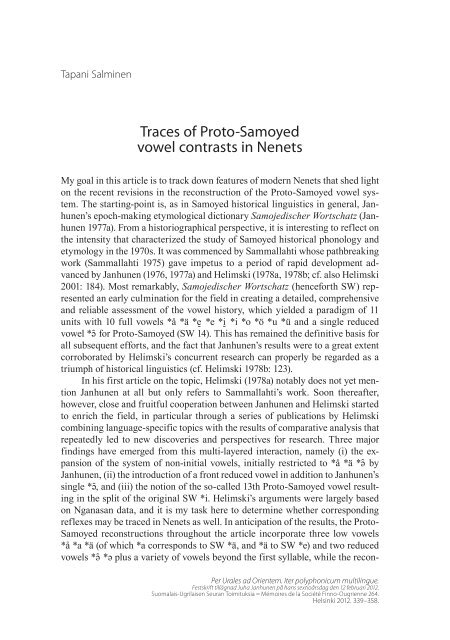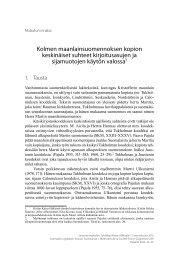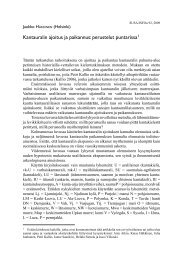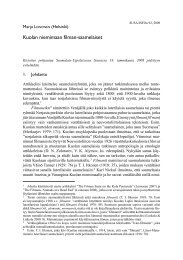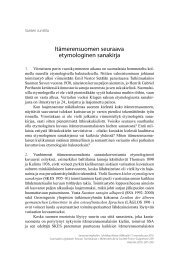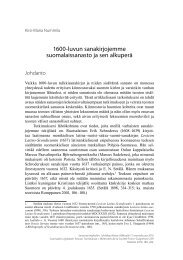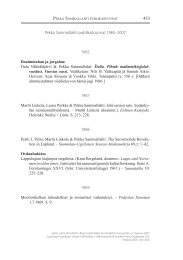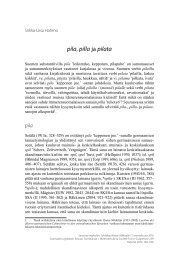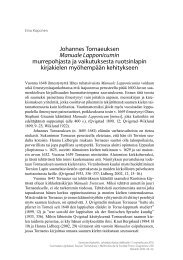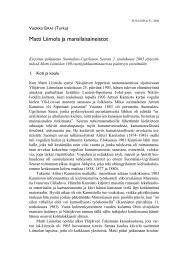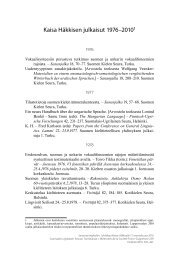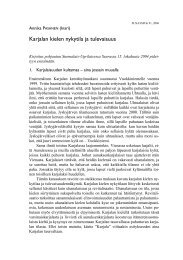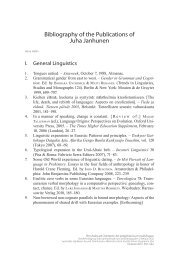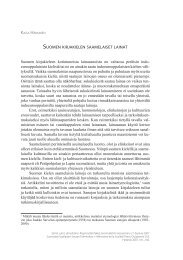Traces of Proto-Samoyed vowel contrasts in Nenets
Traces of Proto-Samoyed vowel contrasts in Nenets
Traces of Proto-Samoyed vowel contrasts in Nenets
Create successful ePaper yourself
Turn your PDF publications into a flip-book with our unique Google optimized e-Paper software.
Tapani Salm<strong>in</strong>en<br />
<strong>Traces</strong> <strong>of</strong> <strong>Proto</strong>-<strong>Samoyed</strong><br />
<strong>vowel</strong> <strong>contrasts</strong> <strong>in</strong> <strong>Nenets</strong><br />
My goal <strong>in</strong> this article is to track down features <strong>of</strong> modern <strong>Nenets</strong> that shed light<br />
on the recent revisions <strong>in</strong> the reconstruction <strong>of</strong> the <strong>Proto</strong>-<strong>Samoyed</strong> <strong>vowel</strong> system.<br />
The start<strong>in</strong>g-po<strong>in</strong>t is, as <strong>in</strong> <strong>Samoyed</strong> historical l<strong>in</strong>guistics <strong>in</strong> general, Janhunen’s<br />
epoch-mak<strong>in</strong>g etymological dictionary Samojedischer Wortschatz (Janhunen<br />
1977a). From a historiographical perspective, it is <strong>in</strong>terest<strong>in</strong>g to reflect on<br />
the <strong>in</strong>tensity that characterized the study <strong>of</strong> <strong>Samoyed</strong> historical phonology and<br />
etymology <strong>in</strong> the 1970s. It was commenced by Sammallahti whose pathbreak<strong>in</strong>g<br />
work (Sammallahti 1975) gave impetus to a period <strong>of</strong> rapid development advanced<br />
by Janhunen (1976, 1977a) and Helimski (1978a, 1978b; cf. also Helimski<br />
2001: 184). Most remarkably, Samojedischer Wortschatz (henceforth SW) represented<br />
an early culm<strong>in</strong>ation for the field <strong>in</strong> creat<strong>in</strong>g a detailed, comprehensive<br />
and reliable assessment <strong>of</strong> the <strong>vowel</strong> history, which yielded a paradigm <strong>of</strong> 11<br />
units with 10 full <strong>vowel</strong>s *å *ä *e̮ *e *i̮ *i *o *ö *u *ü and a s<strong>in</strong>gle reduced<br />
<strong>vowel</strong> *ə̑ for <strong>Proto</strong>-<strong>Samoyed</strong> (SW 14). This has rema<strong>in</strong>ed the def<strong>in</strong>itive basis for<br />
all subsequent efforts, and the fact that Janhunen’s results were to a great extent<br />
corroborated by Helimski’s concurrent research can properly be regarded as a<br />
triumph <strong>of</strong> historical l<strong>in</strong>guistics (cf. Helimski 1978b: 123).<br />
In his first article on the topic, Helimski (1978a) notably does not yet mention<br />
Janhunen at all but only refers to Sammallahti’s work. Soon thereafter,<br />
however, close and fruitful cooperation between Janhunen and Helimski started<br />
to enrich the field, <strong>in</strong> particular through a series <strong>of</strong> publications by Helimski<br />
comb<strong>in</strong><strong>in</strong>g language-specific topics with the results <strong>of</strong> comparative analysis that<br />
repeatedly led to new discoveries and perspectives for research. Three major<br />
f<strong>in</strong>d<strong>in</strong>gs have emerged from this multi-layered <strong>in</strong>teraction, namely (i) the expansion<br />
<strong>of</strong> the system <strong>of</strong> non-<strong>in</strong>itial <strong>vowel</strong>s, <strong>in</strong>itially restricted to *å *ä *ə̑ by<br />
Janhunen, (ii) the <strong>in</strong>troduction <strong>of</strong> a front reduced <strong>vowel</strong> <strong>in</strong> addition to Janhunen’s<br />
s<strong>in</strong>gle *ə̑ , and (iii) the notion <strong>of</strong> the so-called 13th <strong>Proto</strong>-<strong>Samoyed</strong> <strong>vowel</strong> result<strong>in</strong>g<br />
<strong>in</strong> the split <strong>of</strong> the orig<strong>in</strong>al SW *i. Helimski’s arguments were largely based<br />
on Nganasan data, and it is my task here to determ<strong>in</strong>e whether correspond<strong>in</strong>g<br />
reflexes may be traced <strong>in</strong> <strong>Nenets</strong> as well. In anticipation <strong>of</strong> the results, the <strong>Proto</strong>-<br />
<strong>Samoyed</strong> reconstructions throughout the article <strong>in</strong>corporate three low <strong>vowel</strong>s<br />
*å *a *ä (<strong>of</strong> which *a corresponds to SW *ä, and *ä to SW *e) and two reduced<br />
<strong>vowel</strong>s *ə̑ *ə plus a variety <strong>of</strong> <strong>vowel</strong>s beyond the first syllable, while the recon-<br />
Per Urales ad Orientem. Iter polyphonicum multil<strong>in</strong>gue.<br />
Festskrift tillägnad Juha Janhunen på hans sextioårsdag den 12 februari 2012.<br />
Suomalais-Ugrilaisen Seuran Toimituksia = Mémoires de la Société F<strong>in</strong>no-Ougrienne 264.<br />
Hels<strong>in</strong>ki 2012. 339–358.
340 Tapani Salm<strong>in</strong>en<br />
structions <strong>in</strong> SW are, as a rule, given <strong>in</strong> parentheses. The discussion on these<br />
three major discoveries is supplemented by a brief survey <strong>of</strong> the ways <strong>in</strong> which<br />
reconstructions may be updated through a more precise understand<strong>in</strong>g <strong>of</strong> the<br />
quantity relations <strong>in</strong> <strong>Nenets</strong>.<br />
In what follows, Tundra <strong>Nenets</strong> words are generally given <strong>in</strong> phonological<br />
transcription, developed <strong>in</strong> cooperation with Janhunen; the current version<br />
employs the letters ə and ŋ for the respective “ø” and “ng” used <strong>in</strong> a number <strong>of</strong><br />
earlier publications. For Forest <strong>Nenets</strong>, the notation is the same as <strong>in</strong> Salm<strong>in</strong>en<br />
(2007). For other languages, I quote the sources faithfully unless stated otherwise.<br />
Nganasan material <strong>in</strong> particular derives ma<strong>in</strong>ly from the school dictionary<br />
(Zhdanova & Kosterk<strong>in</strong>a & Momde 2001) meticulously edited by Gusev, which<br />
means that the Cyrillic orthography is used for Nganasan. Some <strong>of</strong> the Tundra<br />
Enets words derive from Helimski’s unpublished records through personal communication.<br />
Selkup words are quoted from Donner & Sirelius & Alatalo (2004).<br />
The system <strong>of</strong> non-<strong>in</strong>itial <strong>vowel</strong>s<br />
Janhunen limited the system <strong>of</strong> non-<strong>in</strong>itial <strong>vowel</strong>s to the extreme m<strong>in</strong>imum <strong>of</strong><br />
*å *ä *ə̑ not only on the basis <strong>of</strong> comparative evidence but also draw<strong>in</strong>g from<br />
<strong>in</strong>ternal reconstruction <strong>of</strong> <strong>Nenets</strong>. For <strong>in</strong>stance, <strong>in</strong>s<strong>of</strong>ar as Tundra <strong>Nenets</strong> accusative<br />
plural forms <strong>of</strong> the type xəno <strong>of</strong> xən° ‘sledge’ come from <strong>Proto</strong>-<strong>Samoyed</strong><br />
forms end<strong>in</strong>g <strong>in</strong> *-ə̑ j, <strong>in</strong> this case *kə̑ ncə̑ j > Nganasan кəндəй, all words with a<br />
non-<strong>in</strong>itial o <strong>in</strong> Tundra <strong>Nenets</strong> were deemed to derive similarly from a respective<br />
sequence *ə̑ j, e.g. (SW 35) *jə̑ ptə̑ -j > PN *jəpto > TN yəbto ‘goose’, a conclusion<br />
supported by the status <strong>of</strong> the word as a derivative <strong>of</strong> the verb *jə̑ ptə̑ - > *jəptə-<br />
> yəbtə- ‘moult’. Janhunen’s model <strong>of</strong> <strong>in</strong>ternal reconstruction is <strong>in</strong> many ways<br />
<strong>in</strong>genious, but it has its risks. For <strong>in</strong>stance, abstract stems <strong>of</strong> the type (SW 54)<br />
*kə̑ ptə̑ - (<strong>in</strong>tr.) ‘erlöschen’ led Katz (1996) signally astray as he started regard<strong>in</strong>g<br />
them as someth<strong>in</strong>g primary and orig<strong>in</strong>al, although <strong>in</strong> SW they only serve a<br />
purpose as part <strong>of</strong> larger reconstructions, thought to <strong>in</strong>volve *j by Janhunen but<br />
now argued by Aikio (2002: 11) and Gusev (2008: 125) as hav<strong>in</strong>g *w <strong>in</strong>stead.<br />
Helimski (1978b), on the other hand, demonstrated that nouns <strong>of</strong> this type<br />
generally have a labial <strong>vowel</strong> <strong>in</strong> Nganasan and <strong>in</strong> fact most <strong>Samoyed</strong> languages,<br />
cf. Ng дебту ‘goose’. If *jə̑ ptə̑ j becomes дебту <strong>in</strong> Nganasan while *kə̑ ncə̑ j<br />
emerges as кəндəй, the latter form would have to represent analogical reanalysis<br />
by attach<strong>in</strong>g the accusative plural end<strong>in</strong>g directly to the genitive stem. While<br />
such a hypothesis is not implausible as such, and the apparent lack <strong>of</strong> nouns with<br />
a stem-f<strong>in</strong>al sequence əй would rather support it, comparative data rather overwhelm<strong>in</strong>gly<br />
po<strong>in</strong>ts to the contrary hypothesis, namely that ‘goose’ was already<br />
*jə̑ pto <strong>in</strong> <strong>Proto</strong>-<strong>Samoyed</strong>. Furthermore, two <strong>of</strong> the most frequent o-stem nouns<br />
<strong>in</strong> <strong>Nenets</strong> derive from proto-forms with a second-syllable labial <strong>vowel</strong> plus a<br />
f<strong>in</strong>al glide (Helimski 1978b: 124), i.e. TN ŋəno ‘boat’ ~ Ng ңəндуй < PS *ə̑ ntoj<br />
(SW 15 *ə̑ ntə̑ j) and TN yəŋko ‘trap’ ~ Ng деңгуй < PS *jə̑ ŋkoj (SW 35 *jə̑ ŋkə̑ j).
<strong>Traces</strong> <strong>of</strong> <strong>Proto</strong>-<strong>Samoyed</strong> <strong>vowel</strong> <strong>contrasts</strong> <strong>in</strong> <strong>Nenets</strong><br />
341<br />
The dialectal Tundra <strong>Nenets</strong> accusative plural yəŋkoyo (Lehtisalo 1956: 83a) <strong>in</strong>stead<br />
<strong>of</strong> the synchronically regular yəŋku appears to conta<strong>in</strong> a relic <strong>of</strong> the orig<strong>in</strong>al<br />
glide, deriv<strong>in</strong>g from PS *jə̑ ŋkojə̑ j, although modern forms may themselves<br />
be analogical, for <strong>in</strong>stance the same consultant used both yəbtu and yəbtoyo for<br />
‘goose’ acc.pl (Lehtisalo 1956: 83b). Helimski’s assumption <strong>of</strong> second-syllable<br />
labial <strong>vowel</strong>s also simplified <strong>Proto</strong>-<strong>Samoyed</strong> phonotactics (Helimski 1978b:<br />
124), cf. TN ŋesoh ‘jo<strong>in</strong>t’ < PN *ŋesoŋ ~ Ng ңадюй : ңасунə- < PS *e̮ soń (SW 15<br />
*e̮ sə̑ jn²). Indeed, for ‘boat’ and ‘trap’ one would have had to reconstruct **ə̑ ntə̑ jj<br />
and **jə̑ ŋkə̑ jj to make them work <strong>in</strong> the SW framework.<br />
There are still notable problems with the reconstruction <strong>of</strong> non-<strong>in</strong>itial labial<br />
mid <strong>vowel</strong>s. For <strong>in</strong>stance, an apparently unetymological f<strong>in</strong>al consonant, typically<br />
ŋ, is found <strong>in</strong> Castrén’s Nganasan records <strong>of</strong> words such as ‘goose’ (Castrén<br />
1855). Janhunen <strong>in</strong> SW describes the consonant as a derivational suffix while<br />
Helimski (1978b) regards it as paragogic, whereas Gusev (2008) identifies it with<br />
PS stem-f<strong>in</strong>al *w, with particular reference to Mator data (Helimski 1997; cf.<br />
also Alatalo 1999). Gusev’s assessment undoubtedly clarifies matters, but questions<br />
rema<strong>in</strong> that can only be answered by a more comprehensive study. For <strong>in</strong>stance,<br />
Gusev does not discuss ‘goose’ itself, apparently because its morphophonology<br />
shows it to have a stem-f<strong>in</strong>al <strong>vowel</strong> (poss. 3sg дебтуз̌ у) and no cognate is<br />
found <strong>in</strong> Mator. At the same time, дөйба ‘orphan’ is supposed to show the effect<br />
<strong>of</strong> an orig<strong>in</strong>al f<strong>in</strong>al consonant (Gusev 2008: 117), but Zhdanova & Kosterk<strong>in</strong>a &<br />
Momde (2001) record the possessive form дөйбаз̌ у, <strong>in</strong>dicative <strong>of</strong> a normal <strong>vowel</strong><br />
stem. Similarly, the strong grade <strong>in</strong> Ng бету ‘bowel’ would warrant explanation<br />
<strong>in</strong> Gusev’s framework; <strong>of</strong> the two Mator records, bedöh would appear more reliable<br />
than ?bedüh (Helimski 1997: 215), cf. TN yedyo as opposed to Mt kaduh<br />
‘бу́ря’ ~ TN xad° ‘пурга́’, discussed below. It is a quirk <strong>of</strong> fate that the only<br />
word <strong>of</strong> the ‘bowel’ type with a Uralic background plus a gradable consonant for<br />
Nganasan is only attested <strong>in</strong> Kamas and <strong>Nenets</strong>, i.e. TN nado ‘sister/brother-<strong>in</strong>law<br />
younger than spouse’ ~ FN natu < PN *nato ~ Km nado < PS *nåto (SW 98<br />
*nåt¹ə̑ - (? *nåt¹ə̑ j) ‘Schwager’) < PU *nataw (Sammallahti 1988: 539 *nåtiw; cf.<br />
Gusev 2008: 126).<br />
<strong>Proto</strong>-<strong>Nenets</strong> *æ was found <strong>in</strong> all positions, but after palatal consonants it<br />
later merged with other <strong>vowel</strong>s, i.e. PN *yæ > TN yí ~ FN ye (Salm<strong>in</strong>en 2007:<br />
367). Furthermore, í and æ do not occur <strong>in</strong> non-<strong>in</strong>itial syllables <strong>in</strong> modern Tundra<br />
<strong>Nenets</strong>, with i and e respectively be<strong>in</strong>g used <strong>in</strong> their stead. In <strong>in</strong>itial syllables,<br />
PN *æ unequivocally derives from <strong>vowel</strong>-glide sequences, e.g. TN xæx° ‘и́ дол’<br />
< PN *kækə ~ Ng койкə < PS *kåjkə̑ (SW 51 *kə̑ jkə̑ ; Helimski 1997: 262 *kajkə)<br />
and TN tæwa ‘tail (<strong>of</strong> an animal)’ < PN *tæwa ~ Ng тəйбу < PS *t¹ə̑ jwå (SW<br />
150 *t¹åjwå; Helimski 1997: 349 *tajwa [!]). In non-<strong>in</strong>itial syllables, a similar<br />
development must be assumed on the basis <strong>of</strong> the accusative plural stem <strong>in</strong> particular,<br />
for <strong>in</strong>stance TN ŋuda ‘hand’ : acc.pl ŋudyi < PN *ŋuta : *ŋutyæ < PS<br />
*utå : *utäj (not <strong>in</strong> SW but potentially *utå-j; cf. Salm<strong>in</strong>en 2007: 367). From PS<br />
*äj > PN *yæ it may be further extrapolated that the <strong>Proto</strong>-<strong>Nenets</strong> non-<strong>in</strong>itial<br />
*æ after non-palatal consonants derives from *åj, now vacated <strong>in</strong> the recon-
342 Tapani Salm<strong>in</strong>en<br />
struction system thanks to the replacement <strong>of</strong> SW *åj with *äj, e.g. (eastern)<br />
TN xale ‘fish’ acc.pl < PN *kalæ < PS *kålåj. In other cases <strong>of</strong> PN non-<strong>in</strong>itial<br />
*æ, comparative material is scarce and partly contradictory, which makes it difficult<br />
to venture even tentative reconstructions, but it can safely be said that<br />
the reflexes such as TN tideh ‘Siberian p<strong>in</strong>e’ < PN *titæŋ ~ Sk ti̮ təŋ id. imply<br />
neither the *ə̑ jə̑ sequence posited by Janhunen (SW 160 *ti̮ tə̑ jə̑ ŋ) nor the secondsyllable<br />
*e̮ reconstructed by Helimski (1991 [2000: 15] *ti̮ te̮ ŋ). Indicative examples<br />
<strong>in</strong>clude TN pəreh ‘drill’ < PN *pəræŋ ~ TE pore’ ~ Sk paräŋ ‘Eishaue’<br />
(SW 114 *pə̑ rə̑ jə̑ ŋ), TN tyamteq ‘frog’ < PN *tyamtæq ~ Sk čāmčä id. (SW 114<br />
*cämcə̑ jə̑ ), TN toxeq ‘fabric, textile’ < PN *tokæq ~ Ng тугы” id. (where gradation<br />
rules out any reconstruction <strong>in</strong>volv<strong>in</strong>g an open second syllable), and TN<br />
nyade ‘Renntierkalb, das e<strong>in</strong>ige Wochen später als normalerweise geboren ist’ <<br />
PN *nyatæ ~ TE naδi ‘телёнок’. It is true, however, that the Tundra <strong>Nenets</strong> stem<br />
type exemplified by xæw°di° : poss. nom.sg2sg xæw°der° ‘rib’ ~ FN käw°tä ~<br />
Ng кəиз̌ əə < PS ? *kə̑ jwə̑ tə̑ jə̑ (SW 57–58: TN < *kåjwə̑ tə̑ -jə̑ ) seems to conform<br />
to Janhunen’s orig<strong>in</strong>al reconstruction, and the general picture is complicated<br />
by the fact that yet another stem type with second-syllable e exists <strong>in</strong> Tundra<br />
<strong>Nenets</strong>, e.g. sirey° : poss. nom.sg2sg sirer° ‘двухгодова́лая ва́женка’ ~ TE sire<br />
< PS ? *si̮ råjə̑ vs sirey° : pros. sirey°wəna (not *sirew°na) ‘зи́ мний’ ~ TE sireo<br />
< PS ? *si̮ råjjə̑ , both derived from TN sira ‘snow’ < PS *si̮ rå. At the same time,<br />
Forest <strong>Nenets</strong> preserves PS *ə̑ jə̑ -sequences at least when secondary stress is<br />
<strong>in</strong>volved, e.g. TN xæw°xi° ‘находя́ щийся на какой-л. стороне́’ ~ FN käw°xăj°<br />
‘находя́ щийся ря́дом, продо́льный’ (Barmich & Vello 1994, Lehtisalo 1956:<br />
108a, 495b) < PS *kə̑ jwə̑ kə̑ jə̑ , cf. Ng лабсəкəə ‘после́дний (мла́дший) ребёнок<br />
в семье́, после́дыш’ < PS *le̮ psə̑ kə̑ jə̑ with the same suffix comb<strong>in</strong>ation; cf. also<br />
the narrative suffix, e.g. FN narr. 3sg tĭramăj° ‘es ist vertrocknet’ : 2sg tĭramän°<br />
~ TN tirawi° : tirawen° id., vs the perfective participle suffix, e.g. FN tĭramä ~<br />
TN tirawi° ‘вы́ сушенный’, as well as FN wĭł°năjăł- ~ TN wir°ner- ‘(ohne zu<br />
f<strong>in</strong>den / überall) suchen’ (Lehtisalo 1956: 73a).<br />
Unlike non-<strong>in</strong>itial mid <strong>vowel</strong>s, the case for non-<strong>in</strong>itial high <strong>vowel</strong>s (*i,<br />
*i̮ , *u, *ü) is relatively straightforward: they occurred <strong>in</strong> <strong>Proto</strong>-<strong>Samoyed</strong>, but<br />
merged with the reduced <strong>vowel</strong> *ə̑ <strong>in</strong> <strong>Proto</strong>-<strong>Nenets</strong>, which is basically why they<br />
are not present <strong>in</strong> SW. Recogniz<strong>in</strong>g <strong>Proto</strong>-<strong>Samoyed</strong> *u-stems is possible on the<br />
basis <strong>of</strong> both the comparative method and <strong>in</strong>ternal reconstruction. Enets preserves<br />
the f<strong>in</strong>al <strong>vowel</strong> <strong>in</strong>tact, while Nganasan shows a high <strong>vowel</strong> with characteristic<br />
sound changes, e.g. FN ŋan° ‘louse’ < PN *ŋannə ~ TE adu ~ Sk unču <<br />
PS *åncu (SW 18 *åncə̑ ), TN ŋerm° ‘north’ < PN *ŋermə ~ TE umu ~ Ng ңарми/<br />
ңармү ‘се́веро-восто́ чный ве́тер’ < PS *e̮ rmu (SW 22 *e̮ rmə̑ ), TN ŋay° ‘thaw’<br />
< PN *ŋajə ~ TE aju ‘сля́ коть’ < PS *åju, TN yamp° ‘long’ < PN *jampə ~ TE<br />
d'abu ~ Sk ćumpu < PS *jåmpu (SW 37 *jåmpə̑ ), TN yar° ‘плач’ < PN *jarə ~<br />
Ng дөри/дөрү ~ Sk ćūru < PS *jåru (SW 38 *jårə̑ ), TN xər° ‘knife’ < PN *kərə<br />
~ TE koru < PS *kə̑ ru (SW 54 *kə̑ rə̑ ), and TN xad° ‘пурга́’ < PN *katə ~ TE<br />
kaδu ~ Ng коз̌ у ~ Sk qoču [!] < PS *kåcu (SW 57 *kåcə̑ ). Similar reflexes are<br />
attested <strong>in</strong> Sayan <strong>Samoyed</strong> languages, but <strong>in</strong> a number <strong>of</strong> cases a f<strong>in</strong>al conso-
<strong>Traces</strong> <strong>of</strong> <strong>Proto</strong>-<strong>Samoyed</strong> <strong>vowel</strong> <strong>contrasts</strong> <strong>in</strong> <strong>Nenets</strong><br />
343<br />
nant, identified as *w by Gusev (2008), seems to have been either preserved or<br />
added after the f<strong>in</strong>al labial <strong>vowel</strong>, which means that the above reconstructions<br />
are only <strong>in</strong>tended as tentative representations for highlight<strong>in</strong>g the contrast with<br />
the reconstructions <strong>in</strong> SW.<br />
Curiously, a merger rem<strong>in</strong>iscent <strong>of</strong> <strong>Nenets</strong> also took place <strong>in</strong> Northern<br />
Selkup, which thanks to its prom<strong>in</strong>ence was another key language for Janhunen’s<br />
reconstructions. He was therefore quite understandably led to regard<br />
the reduced <strong>vowel</strong> as orig<strong>in</strong>al and analyze many <strong>of</strong> the labial <strong>vowel</strong>s <strong>in</strong> Nganasan<br />
and Enets as derivational suffixes. Labial high <strong>vowel</strong>s were obviously not<br />
restricted to stem-f<strong>in</strong>al positions but occurred stem-<strong>in</strong>ternally as well as <strong>in</strong> suffixes,<br />
e.g. TN nyax°r ‘three’ < PN *nyakər ~ TE nexu’ ~ Ng нагүр < PS *nakur<br />
(SW 99 *näkə̑ r ? ~ *näkə̑ jr), TN mət°q ‘six’ < PN *məqtəq ~ TE motu’ ~ Ng<br />
мəтү” < PS *mə̑ ktut (SW 85 *mə̑ ktə̑ t ? ~ *mə̑ ktə̑ jt), TN nyar°q ‘across’ < PN<br />
*nyarəq ~ FE naru’ ~ Sk ārut < PS *arut (SW 21 *ärə̑ t³), and the subord<strong>in</strong>ative<br />
marker TN -b°q < PN *-pəq ~ Ng -хү”, also with an orig<strong>in</strong>al labial high <strong>vowel</strong><br />
(Helimski 1978b); cf. also the hortative marker TN -xə < PN *-kə ~ Ng -ку : -гу<br />
and its wider connections with<strong>in</strong> Uralic. The *ə̑ j-sequences <strong>in</strong> SW were obviously<br />
meant to overcome the problem with labial <strong>vowel</strong>s, but even <strong>in</strong> Janhunen’s<br />
own framework they would have produced o’s <strong>in</strong> Tundra <strong>Nenets</strong> etc. <strong>in</strong>stead <strong>of</strong><br />
the reflexes that we actually f<strong>in</strong>d.<br />
As for <strong>in</strong>ternal reconstruction, derivational morphology <strong>in</strong> both <strong>Nenets</strong> languages<br />
reveals *u-nouns, notably through translative verbs end<strong>in</strong>g <strong>in</strong> um rather<br />
than om, e.g. TN ŋayum- ‘наступи́ ть – об о́ ттепели’ ~ FN ŋijum- id. < PN<br />
*ŋajum-, TN yampum- ‘удлини́ ться’ ~ FN jimpum- id. < PN *jampum-, TN<br />
yarum- ‘запла́кать’ < PN *jarum-, TN xadum- ‘нача́ться, подня́ ться – о пурге́’<br />
~ FN kitum- ‘start snow<strong>in</strong>g’ < PN *katum-, and TN píwum- ‘вы́ ветриться’<br />
~ FN piwum- id. < PN *píwum-; cf. TN təbom- ‘покры́ ться песко́м’ < PN<br />
*təpom- (from TN təb° ‘sand’ < PN *təpə ~ TE tobo < PS *t¹ə̑ pə̑ ). At least <strong>in</strong><br />
Forest <strong>Nenets</strong>, the dist<strong>in</strong>ction is also present <strong>in</strong> <strong>in</strong>flection, cf. ŋan° ‘louse’ : acc.pl<br />
ŋ<strong>in</strong>u < PN *ŋannu < PS *åncuj (cf. kăn° ‘sledge’ : acc.pl kănu < PN *kənno <<br />
PS *kə̑ ncə̑ j); analogical forms <strong>of</strong> the type acc.pl ŋanu appear as well (cf. Lehtisalo<br />
1956: 18b), but even today conservative speakers prefer the orig<strong>in</strong>al forms<br />
with metaphony caused by the orig<strong>in</strong>al second-syllable high <strong>vowel</strong>. Other similar<br />
accusative plural stems recorded by Lehtisalo (1956) <strong>in</strong>clude waps° : wipsu<br />
‘Rede’, jaw° : jiwu ‘Harn’ (analogically also jawu), japs° : jipsu ‘Bratstäbchen’,<br />
law° : liwu ‘Pferd’ (~ lawu, a Khanty loanword for which the metaphonic form<br />
itself may be analogical), mat° : mitu ‘Bellen, Gebell (лай) (des Hundes, Wolfes,<br />
Fuchses)’ ~ FE maδu ‘лай’ (cf. Sorok<strong>in</strong>a & Bol<strong>in</strong>a 2001: 66); cf. also päx° : pixu<br />
‘an der Luft getrockneter Fisch’ ~ Ng хуакы : gen.pl хуагы” ‘ю́ кола (вя́леная<br />
ры́ ба)’. Similar records from Tundra <strong>Nenets</strong> are rare, for <strong>in</strong>stance хаду” лэңгор”<br />
‘сне́жные ту́чи’ (Tereshchenko 1965: 255) would appear to conta<strong>in</strong> the genitive<br />
plural ?xaduq < PN *katuq rather than the synchronically regular xad°q <strong>of</strong> xad°<br />
‘пурга́’ (Salm<strong>in</strong>en 1998a: 55; cf. also Salm<strong>in</strong>en 1997: 89–90). Mov<strong>in</strong>g to apparent<br />
*ü-stems, a similar case is the Tundra <strong>Nenets</strong> accusative plural stem ?tyíryi
344 Tapani Salm<strong>in</strong>en<br />
rather than the analogical (and firmly attested) tyírye (Salm<strong>in</strong>en 1998a: 132;<br />
?tyír° could also be a potential variant) <strong>of</strong> tyír° ‘cloud’, supported by records with<br />
stressed second syllables, e.g. техэ” тирид ‘те далёкие облака́’ with poss.<br />
nom.pl2sg ?tyíryid° (Tereshchenko 1965: 349) where simple phonetic rais<strong>in</strong>g<br />
typical <strong>of</strong> many dialects does not come <strong>in</strong>to question (Salm<strong>in</strong>en 1998b: 521).<br />
The correct <strong>Proto</strong>-<strong>Samoyed</strong> reconstruction would appear to be *tiərü (Helimski<br />
1978b: 125 *tiə̑ rü; cf. SW 162 *tiə̑ -(j)rə̑ ; Salm<strong>in</strong>en 1997: 90 with <strong>in</strong>correct f<strong>in</strong>al<br />
*i) > TE ciori ~ Ng чиирү id.<br />
The distribution <strong>of</strong> non-<strong>in</strong>itial *u vs *ü (as well as *i̮ vs *i) seems to have<br />
generally followed palatal harmony, and the frontness was therefore not dist<strong>in</strong>ctive<br />
as such, although it seems that <strong>vowel</strong> harmony was relaxed <strong>in</strong> suffixes<br />
from early on. The *ü-nouns <strong>in</strong> particular that may be reconstructed <strong>in</strong> <strong>Proto</strong>-<br />
<strong>Samoyed</strong> are not numerous, but besides ‘cloud’ these <strong>in</strong>clude two old k<strong>in</strong>ship<br />
terms, namely TN syel° ‘sister’s husband’ ~ FN syel° < PN *syelə < PS *kälü <<br />
PU *käliw (Sammallahti 1988: 538 *käläw) and TN yiy° ‘son-<strong>in</strong>-law’ ~ FN wyĭj°<br />
< PN *wyijə ~ Ng биңи < PS *weŋü (SW 176 *wiŋə̑ ) < PU *we/äŋiw (Sammallahti<br />
1988: 541). There is less <strong>Nenets</strong> material for <strong>in</strong>ternal reconstruction <strong>of</strong> these<br />
words; on the basis <strong>of</strong> the above discussion, the Tundra <strong>Nenets</strong> denom<strong>in</strong>al verbs<br />
yiyom- ‘стать зя́ тем’ and yiyoq- ‘быть зя́ тем; называ́ть зя́ тем’ (Tereshchenko<br />
1965: 139) would appear to be analogical, while no correspond<strong>in</strong>g Forest <strong>Nenets</strong><br />
records have been attested. Verbal nouns <strong>of</strong> the type TN my<strong>in</strong>° ‘движе́ние,<br />
направле́ние’ ~ FN myĭn° < PN *my<strong>in</strong>ə ~ Ng мыну (: poss. 3sg мынуз̌ ы)<br />
‘движе́ние’ < PS *menü (not <strong>in</strong> SW but potentially *m<strong>in</strong>ə̑ ) < PU *meniw would<br />
seem to belong here as well.<br />
Unlike non-<strong>in</strong>itial *u and *ü, whose recognition requires either comparison<br />
with other <strong>Samoyed</strong> languages or recourse to <strong>in</strong>ternal reconstruction, non<strong>in</strong>itial<br />
*i has left an overt trace by palataliz<strong>in</strong>g the preced<strong>in</strong>g consonant, preserved<br />
<strong>in</strong> Forest <strong>Nenets</strong> but, except <strong>in</strong> the case <strong>of</strong> *sy, depalatalized <strong>in</strong> Tundra<br />
<strong>Nenets</strong>. Many <strong>of</strong> these words have cognates <strong>in</strong> Enets and Nganasan but rather<br />
few <strong>in</strong> southern <strong>Samoyed</strong> and therefore only a small number <strong>of</strong> *i-nouns appear<br />
<strong>in</strong> SW, e.g. TN yen° ‘bowstr<strong>in</strong>g’ ~ FN jeny° < PN *jennyə ~ Ng денті ~ Sk<br />
ć<strong>in</strong>ti < PS *jänti (SW 43 *jentə̑ ; also Janhunen 2007: 215), TN mərcy° ‘shoulder’<br />
~ FN măłsy° < PN *mərsyə ~ TE mod'i ~ Ng мəрсы < PS *mərki (SW 88<br />
*mə̑ rkä), TN yempəq- ‘dress’ ~ FN jempyăq- < PN *jempyəq- ~ Ng демби”- ~<br />
Sk će̮ mpət- / ći̮ mpət- [!] < PS *jämpit- (SW 42 *jempə̑ t- ? ~ *jempə̑ jt-), TN<br />
pyency°r ‘shaman’s drum’ < PN *pyensyər ~ Ng хеньдир < PS *päŋkir (SW 119<br />
*peŋkär; cf. Janhunen 1986b: 108, Helimski 1991 [2000: 16], Janhunen 2005:<br />
23, 24 *pe-n-kir, Salm<strong>in</strong>en 2005: 71–72, Anik<strong>in</strong> & Helimski 2007: 77); cf. also,<br />
for <strong>in</strong>stance, TN yerə- ‘распоро́ ть’ ~ FN wyełyă- < PN *wyeryə- ~ Ng бери-<br />
‘разре́зать, раскрои́ ть’ < PS *wäri-, as well as FN syapty° ‘древе́сная кора́’ :<br />
syiptyun- ‘ободра́ть, снять кору́ (с деревьев)’ as opposed to TN syabt° : (analogical)<br />
syabtəh- id. All <strong>in</strong>stances <strong>of</strong> PS *ś, <strong>in</strong>cluded with a question mark <strong>in</strong><br />
SW (9) but already regarded as obsolete by Janhunen (1998: 462), can <strong>in</strong>deed<br />
be readily expla<strong>in</strong>ed by a follow<strong>in</strong>g *i, for example TN pyisy°h ‘laughter’ ~ FN<br />
pyĭsy° < PN *pyisyəŋ ~ Ng хиди ~ Sk pisi < PS *pisiŋ for which SW (126) has<br />
the stem *pisз- (? *piśə̑ -).
<strong>Traces</strong> <strong>of</strong> <strong>Proto</strong>-<strong>Samoyed</strong> <strong>vowel</strong> <strong>contrasts</strong> <strong>in</strong> <strong>Nenets</strong><br />
345<br />
The overall picture is confused by the presence <strong>of</strong> a number <strong>of</strong> TN words<br />
which have not undergone depalatalization, such as xəmty° ‘обры́ в, круто́й<br />
спуск’ ~ TE kodi and xəny°h ‘и́ ней’ ~ FN kăny° ~ TE kodi’, discussed by Helimski<br />
(1984a [2000]). S<strong>in</strong>ce words without depalatalization appear to derive from<br />
earlier forms with second-syllable *i just like the ones with it, the divergence<br />
<strong>of</strong> the two types has presumably occurred only after <strong>Proto</strong>-<strong>Nenets</strong>. A possible,<br />
although unexpected condition<strong>in</strong>g factor might be the first-syllable <strong>vowel</strong>, s<strong>in</strong>ce<br />
besides xəmty° and xəny°h mentioned above, the group with palatality <strong>in</strong>cludes<br />
pədy° ‘захо́д, зака́т’, ŋədyə- ‘видне́ться’, məny° ‘я’, səmnyə- ‘наби́ ть’, xəryə-<br />
‘приби́ ться к земле́’, məlyə- ‘слома́ть, полома́ть’, and pəly°q ‘густо́й’, and<br />
contrary examples with ə <strong>in</strong> the first syllable and depalatalization <strong>of</strong> a dental<br />
consonant (labial consonants are <strong>in</strong>variably depalatalized before *ə <strong>in</strong> TN) do<br />
not seem to exist. It should be noted that there are a few examples with another<br />
first-syllable <strong>vowel</strong>, notably yemnyə- ‘patch’, ŋody°h ~ ŋody°q ‘hardly’, m<strong>in</strong>y°<br />
‘belly (<strong>of</strong> a fish)’, nyany° ‘bread’, w<strong>in</strong>yə- ~ wunyə- ‘not (emphatic)’ and xany°q<br />
‘depart’ conneg., as well as cases <strong>of</strong> dialectal variation such as lyar° ~ lyary°<br />
‘ruffe (Gymnocephalus cernuus)’, but many if not all <strong>of</strong> them can be expla<strong>in</strong>ed<br />
as loans or otherwise secondary formations.<br />
Furthermore, <strong>Proto</strong>-<strong>Samoyed</strong> non-<strong>in</strong>itial *i seems to have been directly<br />
preserved <strong>in</strong> Tundra <strong>Nenets</strong> <strong>in</strong> positions where secondary stress has <strong>of</strong>fered support.<br />
Firstly, <strong>in</strong> many if not all dialects the <strong>in</strong>strumental derivative <strong>of</strong> the type TN<br />
yilyebcy°h ‘wild re<strong>in</strong>deer’ < PN *jilyepsyəŋ < PS *(j)eläps<strong>in</strong> has the accusative<br />
plural with an otherwise <strong>in</strong>explicable <strong>vowel</strong> change, i.e. yilyebcyiye (rather than<br />
?yilyebcyəye; cf. Salm<strong>in</strong>en 1993a) < PN *jilyepsyije. In unstressed syllables, the<br />
same stem type shows regular reduction, e.g. yolcy°h ‘time, measure’ : acc.pl<br />
yolcy°ye < PN *jolsyəje < *jolsyije, although analogical formations are obviously<br />
possible <strong>in</strong> the case <strong>of</strong> semantically transparent <strong>in</strong>strumental nouns. Secondly,<br />
the modern Tundra <strong>Nenets</strong> i found <strong>in</strong> dual suffixes such as <strong>in</strong> xalyaryih<br />
‘your (du) fish (sg)’ or me°dyih ‘you (du) are’ appears to reflect a s<strong>in</strong>gle PS *i<br />
as well, although here its preservation must be attributed to analogy based on<br />
preterite forms where the <strong>vowel</strong> would have been stressed, e.g. me°dy<strong>in</strong>cy° ‘you<br />
(du) were’ < PN *meŋaty<strong>in</strong>syə. In Forest <strong>Nenets</strong>, there are no such exceptions<br />
to the merger <strong>of</strong> the non-<strong>in</strong>itial *i with PN *ə, but the accusative plural form<br />
correspond<strong>in</strong>g to the above is jĭłyipsyăji (not *jĭłyipsyĭji) and the dual forms are<br />
kałyały° < PN *kalyaryəŋ and meŋaty° < PN *meŋatyəŋ : pret. meŋatyănsy°, respectively.<br />
Similar dual suffixes are known from the western dialects <strong>of</strong> Tundra<br />
<strong>Nenets</strong>, for <strong>in</strong>stance (Sjo.) ənobty°h ‘boat’ acc.sg3du (Lehtisalo 1956: 480b) <<br />
PN *ŋənomtyəŋ <strong>in</strong> contrast with ŋənomtyih <strong>in</strong> central and eastern TN.<br />
The case for non-<strong>in</strong>itial *i̮ aga<strong>in</strong> rests on comparative evidence, for example<br />
TN yab° ‘luck’ ~ FN wyap° < PN *wyapə ~ Ng бахи (: poss. 3sg бахиз̌ү)<br />
‘wild re<strong>in</strong>deer’ < PS *wapi̮ (not <strong>in</strong> SW but would be *wäpə̑ ). Janhunen (1998:<br />
465) had already revised the <strong>Proto</strong>-<strong>Samoyed</strong> form as *wäpi, but if the current<br />
reconstruction was <strong>in</strong>deed the presumably disharmonic **wapi, it should have<br />
resulted <strong>in</strong> FN *wyapy° as <strong>in</strong> jempyăq- ‘dress’ discussed above.
346 Tapani Salm<strong>in</strong>en<br />
The case for the front reduced <strong>vowel</strong><br />
Janhunen makes reference to “stems which, <strong>in</strong> spite <strong>of</strong> the lack <strong>of</strong> proper conditions,<br />
do show the effects normally typical <strong>of</strong> the palatal harmony” (Janhunen<br />
1986a: 147). The stems <strong>in</strong> question have a reduced <strong>vowel</strong> (SW *ə̑ ) <strong>in</strong> the first<br />
syllable, and the effects <strong>of</strong> the palatal harmony are shown for <strong>in</strong>stance <strong>in</strong> the<br />
accusative plural formation <strong>in</strong> <strong>Nenets</strong>, e.g. TN tər ‘body-hair’ : acc.pl tərye (Salm<strong>in</strong>en<br />
1997: 66, 72), which <strong>contrasts</strong> with words like TN təh ‘summer’ : acc.pl<br />
təŋo; the same phenomenon is found <strong>in</strong> Forest <strong>Nenets</strong>. In the SW framework, the<br />
respective reconstructions would be *tə̑ r : *tə̑ rə̑ j vs *tə̑ ŋ : *tə̑ ŋə̑ j, which <strong>in</strong>deed<br />
shows the lack <strong>of</strong> proper conditions for the attested second syllable palatality and<br />
<strong>vowel</strong> <strong>in</strong> tərye and similar word-forms.<br />
On the basis <strong>of</strong> Nganasan <strong>in</strong>ternal reconstruction and comparative Uralic<br />
data, Helimski (1993 [2000]) concluded that <strong>Proto</strong>-<strong>Samoyed</strong> had two contrast<strong>in</strong>g<br />
reduced <strong>vowel</strong>s which merged <strong>in</strong> all modern <strong>Samoyed</strong> languages but rema<strong>in</strong><br />
synchronically attestable through Nganasan <strong>vowel</strong> harmony. He also showed<br />
that the two <strong>Proto</strong>-<strong>Samoyed</strong> reduced <strong>vowel</strong>s were unequivocally derived from<br />
two different <strong>Proto</strong>-Uralic <strong>vowel</strong>s, the back one from *u and the front one from<br />
*i. For the front reduced <strong>vowel</strong>, Helimski suggested a curious symbol “ə̈ ”, which<br />
represents an uncharacteristic misjudgement on his part: <strong>in</strong> the F<strong>in</strong>no-Ugrian<br />
Transcription, to which he steadfastly adhered not only <strong>in</strong> phonetic writ<strong>in</strong>g but<br />
also <strong>in</strong> phonological transcription, the diaeresis does not comb<strong>in</strong>e with front<strong>vowel</strong><br />
letters, <strong>in</strong>clud<strong>in</strong>g “ə”. Furthermore, diacritics on reversed characters<br />
revolve accord<strong>in</strong>gly and appear therefore on the opposite side <strong>of</strong> the letter, as<br />
demonstrated by the relationship between *ə̑ and *e̮ . Ins<strong>of</strong>ar as ë is used synonymously<br />
with e̮ (cf. Janhunen 1998), then a conventional symbol “ə̤ ” can certa<strong>in</strong>ly<br />
be designed, but it would then represent the back <strong>vowel</strong> <strong>in</strong> question. Fortunately,<br />
there are no obstacles to us<strong>in</strong>g *ə as the front pair <strong>of</strong> *ə̑ , as it is not only traditional<br />
and logical but also convenient and useful. Helimski’s idea <strong>of</strong> conf<strong>in</strong><strong>in</strong>g<br />
the symbol “ə” to the function <strong>of</strong> an archigrapheme for reduced <strong>vowel</strong>s with<br />
unspecified frontness should be regarded as a moot po<strong>in</strong>t as well, firstly because<br />
synchronic data alone makes it possible to determ<strong>in</strong>e the frontness <strong>of</strong> a reduced<br />
<strong>vowel</strong> <strong>in</strong> the overwhelm<strong>in</strong>g majority <strong>of</strong> cases, and secondly because the idea<br />
contradicts the well-established and function<strong>in</strong>g practice <strong>of</strong> employ<strong>in</strong>g superscript<br />
digits for present<strong>in</strong>g <strong>Proto</strong>-<strong>Samoyed</strong> archigraphemes (SW 14).<br />
Besides Nganasan data, Helimski (1993: 132 [2000: 201]) refers to Tundra<br />
<strong>Nenets</strong> derivatives <strong>of</strong> the types ŋəbtyeq- ‘па́хнуть’ from ŋəbt° ‘за́пах’ vs təŋoq-<br />
‘летова́ть’, parallel to the accusative plural forms tərye vs təŋo cited above; cf.<br />
also təryer- ‘обрасти́ ше́рстью’ as opposed to ŋəwor- ‘есть’ from ŋəm- ‘съесть’.<br />
A reasonably clear picture emerges from these and numerous other examples <strong>in</strong><br />
both <strong>Nenets</strong> languages: there are two k<strong>in</strong>ds <strong>of</strong> words conta<strong>in</strong><strong>in</strong>g only reduced<br />
<strong>vowel</strong>s <strong>in</strong> SW depend<strong>in</strong>g on whether the SW *ə̑ j <strong>in</strong> non-<strong>in</strong>itial syllables yields o<br />
or ye <strong>in</strong> Tundra <strong>Nenets</strong> (and likewise <strong>in</strong> <strong>Proto</strong>-<strong>Nenets</strong>), with no condition<strong>in</strong>g factor.<br />
The only suggested remedy for this shortcom<strong>in</strong>g is, <strong>in</strong>deed, Helimski’s idea
<strong>Traces</strong> <strong>of</strong> <strong>Proto</strong>-<strong>Samoyed</strong> <strong>vowel</strong> <strong>contrasts</strong> <strong>in</strong> <strong>Nenets</strong><br />
347<br />
<strong>of</strong> two reduced <strong>vowel</strong> phonemes for <strong>Proto</strong>-<strong>Samoyed</strong>, and <strong>Nenets</strong> evidence can<br />
<strong>in</strong> retrospect be regarded as equally conclusive. The current reconstruction for<br />
SW (149) *tə̑ r : *tə̑ rə̑ j would therefore be *tər : *tərəj; similarly SW (16) *ə̑ ptə̑<br />
must be replaced with *əptə while for <strong>in</strong>stance SW (148) *t¹ə̑ pə̑ rema<strong>in</strong>s unrevised<br />
on the basis <strong>of</strong> TN təb° ‘sand’ : acc.pl təbo and so forth. It may be added<br />
that the front <strong>vowel</strong>s <strong>of</strong> *tər and its rhyme-word *mər > TN mər : acc.pl mərye<br />
‘wild re<strong>in</strong>deer bull’ further weaken their already hypothetical areal connections<br />
(Janhunen 1977b: 123–124). On the other hand, as long as *jəkə rather than<br />
(SW 34) *jə̑ kə̑ is the correct reconstruction for TN yəx° etc. ‘tw<strong>in</strong>’, the “unaccountable<br />
difficulties” mentioned by Janhunen (1977b: 125–126) concern<strong>in</strong>g the<br />
sound substitutions <strong>in</strong> this word <strong>of</strong> Turkic orig<strong>in</strong> are perhaps easier to overcome<br />
(cf. also Terent’ev 1982); the word is <strong>in</strong>correctly rendered as *yax° by Salm<strong>in</strong>en<br />
(1998a: 151), while Janhunen (1977b: 125–126) had already identified the firstsyllable<br />
<strong>vowel</strong>. For words with both SW *ə̑ and full <strong>vowel</strong>s, a regular system <strong>of</strong><br />
<strong>vowel</strong> harmony must be assumed, so that, for example, SW (170) *wə̑ tå > TN<br />
wəda ‘hook’ requires no revision while SW (115) *pə̑ tä must now be rendered as<br />
*pətä > TN pədya ‘bile’.<br />
The (western) Tundra <strong>Nenets</strong> word mər°q ‘го́род’, quoted by Janhunen<br />
(1986a: 147) as an example <strong>of</strong> the above circumstances, does not seem to belong<br />
to exactly this context, because its apparent eastern TN cognate məry°q ‘забо́р’<br />
would suggest an orig<strong>in</strong>al *i <strong>in</strong> the second syllable. Moreover, the further cognates<br />
<strong>of</strong> the Tundra <strong>Nenets</strong> word are irregular: FN mănły°q id. (Lehtisalo 1956:<br />
242b) has a consonant cluster and TE moru’ ‘укрепле́ние’ (Helimski, personal<br />
communication) reflects back <strong>vowel</strong>s. Areal complexities notwithstand<strong>in</strong>g, a potential<br />
Pre-<strong>Nenets</strong> reconstruction based on TN mər°q ~ məry°q would be *mərit,<br />
and its regular accusative plural *məritəj would yield the attested mər°dye ~<br />
məry°dye as expected.<br />
The <strong>contrasts</strong> among front <strong>vowel</strong>s<br />
Janhunen po<strong>in</strong>ts out that the <strong>Proto</strong>-<strong>Samoyed</strong> “*ä <strong>in</strong> the <strong>in</strong>itial syllable [– –]<br />
behaved like a back <strong>vowel</strong>, while *ä <strong>in</strong> non-<strong>in</strong>itial syllables [– –] was a front<br />
<strong>vowel</strong>”, quot<strong>in</strong>g SW (90) *mät > TN myaq ‘tent’ with loc.sg SW *mätkə̑ nå ><br />
myak°na rather than **mätkə̑ nä > *myak°nya which would have been expected<br />
if <strong>vowel</strong> harmony had applied consistently, cf. SW (176) *wit : *witkə̑ nä > TN<br />
yiq ‘water’ : loc.sg yik°nya (Janhunen 1998: 466). <strong>Nenets</strong> accusative plural forms<br />
such as TN myado vs yidye illustrate the discrepancy further, and the presumed<br />
developments can justifiably be characterized as anomalous. Sound substitutions<br />
<strong>in</strong> early loanwords may also cast doubt on the phonetic value <strong>of</strong> SW *ä (cf.<br />
Terent’ev 1982).<br />
A plausible explanation to the <strong>Nenets</strong> state <strong>of</strong> affairs was aga<strong>in</strong> <strong>of</strong>fered<br />
by Helimski on the basis <strong>of</strong> Nganasan, when he suggested that there had also<br />
been an additional full <strong>vowel</strong> <strong>in</strong> <strong>Proto</strong>-<strong>Samoyed</strong> (Helimski 2005). Until then, the
348 Tapani Salm<strong>in</strong>en<br />
duality <strong>of</strong> Nganasan reflexes <strong>of</strong> SW *i was generally assumed to have emerged<br />
<strong>in</strong> the separate history <strong>of</strong> Nganasan (cf. Mikola 2004: 76–77), although it must<br />
be noted that Sammallahti (1975: 104–105) had already discovered the relevant<br />
sound correspondences, and his full vs reduced front high <strong>vowel</strong>s convey the<br />
same opposition as Helimski’s later split. Helimski, however, succeeded <strong>in</strong> connect<strong>in</strong>g<br />
the contrast with its Uralic background more explicitly, for example Ng<br />
ним ‘name’ < PS *nim (SW 102; a variant *nüm would be secondary) < PU<br />
*nimi, Ng хирə ‘height’ < PS *pirə- (SW 125 *pirə̑ ) < PU *piδi- and Ng бии”<br />
‘ten’ < PS *wüət (SW 177 *wüt) < PU *wiγti are opposed to Ng бы” ‘water’ <<br />
PS *wet (SW 176 *wit) < PU *weti, Ng мын- ‘go’ < PS *men- (SW 94 *m<strong>in</strong>-)<br />
< PU *meni- and Ng хыты ‘nest’ < PS *petä (SW 126 *pitä) < PU *pesä. His<br />
conclusion was therefore that SW *i should be replaced with two <strong>Proto</strong>-<strong>Samoyed</strong><br />
<strong>vowel</strong>s, *i and *e, and that SW *e would then be represented by *ä and SW *ä<br />
by *a <strong>in</strong> the revised <strong>vowel</strong> system; Helimski suggests a variant symbol *ε <strong>in</strong><br />
place <strong>of</strong> the current *ä, but the choice <strong>of</strong> *ä over *ε seems self-evident, given the<br />
system <strong>of</strong> phonological <strong>contrasts</strong> as well as the practical accessibility <strong>of</strong> symbols.<br />
For an <strong>in</strong>structive summary and application <strong>of</strong> the new system, see Aikio<br />
(2006); cf. also Aikio (2002: 49–50).<br />
As Helimski already po<strong>in</strong>ts out, referr<strong>in</strong>g to Janhunen (1998: 466) and Salm<strong>in</strong>en<br />
(1997: 66–67), “even <strong>in</strong> <strong>Nenets</strong>” SW *ä “behaves as an orig<strong>in</strong>al back<br />
<strong>vowel</strong>” (Helimski 2005: 37). The current reconstructions <strong>of</strong> forms like TN myaq<br />
: myak°na : myado mentioned above are accord<strong>in</strong>gly *mat : *matkə̑ nå : *matə̑ j,<br />
and the reflexes turn out to be both regular and expected. Notably the secondsyllable<br />
SW *ä rema<strong>in</strong>s <strong>in</strong>tact <strong>in</strong> the revised system, and all <strong>in</strong>stances <strong>of</strong> *ä now<br />
function as front <strong>vowel</strong>s irrespective <strong>of</strong> phonotactic position.<br />
It turns out that *a must also be added to the <strong>in</strong>ventory <strong>of</strong> <strong>Proto</strong>-<strong>Samoyed</strong><br />
non-<strong>in</strong>itial <strong>vowel</strong>s for words such as TN ŋodya ‘berry’ ~ Ng ңута < PS *(w)ota<br />
(SW 177 *wotз ~ [for Nganasan] ? *otə̑ ), TN xidya ‘cup’ ~ Ng кита < PS *ki̮ ta<br />
(Janhunen 1977b: 125 ? *ki̮ tə̑ jå ~ *ki̮ tə̑ jä), and TN yesya ‘iron’ ~ Ng баса <<br />
PS *wäsa (SW 175 *wesä; cf. Janhunen 1983: 120–121, Aikio 2006: 31). Such<br />
a conclusion expla<strong>in</strong>s the apparent disharmony <strong>of</strong> TN ŋodya and xidya through<br />
the secondary merger <strong>of</strong> <strong>Proto</strong>-<strong>Samoyed</strong> non-<strong>in</strong>itial *a and *ä <strong>in</strong> <strong>Proto</strong>-<strong>Nenets</strong><br />
as *ya, for example PS *wäsa > PN *wyesya > TN yesya vs PS *ämä (SW 23<br />
*emä) > PN *nyemya > TN nyebya ‘mother’ ~ Ng немы id. The retention <strong>of</strong><br />
<strong>Proto</strong>-<strong>Samoyed</strong> non-<strong>in</strong>itial *a and the parallel developments *ä > ы and *å ><br />
у <strong>in</strong> Nganasan prove to be entirely regular as well. Other cases with a similar<br />
sound correspondence <strong>in</strong>clude TN yewa ~ Ng дөйба ‘orphan’, discussed above,<br />
and the F<strong>in</strong>nic loanword TN lúca ~ Ng люо”са ‘Russian’. The non-<strong>in</strong>itial *a also<br />
shows an <strong>in</strong>terest<strong>in</strong>g alternation pattern with *i <strong>in</strong> <strong>in</strong>strumental nouns, e.g. TN<br />
xabcyah ‘disease, death’ < PN *kapsyaŋ < PS *kåə̑ psan vs pad°nəbcy°h ‘pencil’<br />
< PN *patənnəpsyəŋ < PS *påtə̑ ntə̑ ps<strong>in</strong> (cf. Klumpp 2009); cf. also the low vs<br />
high <strong>vowel</strong>s <strong>in</strong> Nganasan suffixes, e.g. дөз̌ əбси ‘ходьба́’ vs дюркəбся ‘не́вод’,<br />
or китəди ‘буди́ ть’ vs барəдя ‘ждать’, with numerous examples provided by<br />
Wagner-Nagy (2009: 114–119).
<strong>Traces</strong> <strong>of</strong> <strong>Proto</strong>-<strong>Samoyed</strong> <strong>vowel</strong> <strong>contrasts</strong> <strong>in</strong> <strong>Nenets</strong><br />
349<br />
While it is true that the correct identification <strong>of</strong> <strong>Proto</strong>-<strong>Samoyed</strong> <strong>vowel</strong>s<br />
require attestation <strong>in</strong> Nganasan <strong>in</strong> a number <strong>of</strong> cases, there are also fresh perspectives<br />
for <strong>in</strong>ternal reconstruction both <strong>in</strong> <strong>Nenets</strong> and elsewhere <strong>in</strong> <strong>Samoyed</strong>,<br />
thanks <strong>in</strong> particular to the recent work on Enets and Selkup, but further research<br />
<strong>in</strong> that direction is beyond the scope <strong>of</strong> this article. It may be added, however,<br />
that PS *ä seems to have been frequently preserved <strong>in</strong> modern Forest Enets, for<br />
<strong>in</strong>stance FE mäsi ‘w<strong>in</strong>d’ ~ TN myercya < PS *märkä (SW 93 *merkä), nänag<br />
‘mosquito’ ~ nyenyaŋk° < *nänaŋkə (SW 23 *nenäŋkə̑ ), säj ‘heart’ ~ syey° <<br />
*säjə (SW 139 *sejə̑ ), or tät ‘four’ ~ tyet° < *tät²tə (SW 159 *tet²tə̑ ; cf. Sorok<strong>in</strong>a<br />
& Bol<strong>in</strong>a 2001: 77, 81, 117, 137); cf. also Mt hälä ‘Hälfte, Seite, halb-’ (Helimski<br />
1997: 242) < PS *pälä (SW 120 *pelä) etc.<br />
The role <strong>of</strong> <strong>Nenets</strong> quantity relations<br />
Janhunen orig<strong>in</strong>ally recognized a system <strong>of</strong> only six <strong>vowel</strong>s (<strong>in</strong> current transcription)<br />
ə a e i o u for what he referred to as standard Tundra <strong>Nenets</strong>, plus an<br />
additional <strong>vowel</strong> æ conf<strong>in</strong>ed to dialects (Janhunen 1986a: 31–32; cf. Janhunen<br />
1984, 1993, Salm<strong>in</strong>en 1993a), which also formed the basis for <strong>Proto</strong>-<strong>Samoyed</strong><br />
<strong>vowel</strong> <strong>contrasts</strong> (Janhunen 1976; cf. Mikola 1988: 219). The earlier view was<br />
motivated by the fact that the quantity <strong>of</strong> the Tundra <strong>Nenets</strong> long high <strong>vowel</strong>s<br />
í ú as opposed to i u was not always recorded accurately by Lehtisalo (1956).<br />
Nevertheless, for comparative purposes Lehtisalo’s Forest <strong>Nenets</strong> material relat<strong>in</strong>g<br />
to the parallel contrast between i u and ĭ ŭ is actually quite reliable <strong>in</strong><br />
this respect, and even the great majority <strong>of</strong> Tundra <strong>Nenets</strong> records are sufficiently<br />
<strong>in</strong>formative for establish<strong>in</strong>g the contrast, as already po<strong>in</strong>ted out by Helimski<br />
(1978a; cf. also Helimski 1984b [2000: 43–44], Salm<strong>in</strong>en 1993b). It may<br />
be noted that Wickman (1958: 103–104) already identified a set <strong>of</strong> subm<strong>in</strong>imal<br />
pairs from Lehtisalo’s data that is still perfectly valid today, i.e. <strong>in</strong> phonological<br />
transcription pyidya ‘Nest’ vs pyídye° ‘verscheuchen’, pyilyo ‘Bremse (Insekt)’<br />
vs pyílyucy° ‘sich fürchten’, tyir ‘Kante’ vs tyír° ‘Wolke’, sira ‘Schnee’ vs síra°<br />
‘sich schämen’, and pur°q ‘Mückenfeuer’ vs púr ‘Rost’.<br />
The most notable word among those whose reconstruction relies on the<br />
quantity contrast is the <strong>Samoyed</strong> numeral ‘ten’, i.e. TN yúq ~ FN jŭq : gen. jut°<br />
~ TE biu’ ~ Ng бии” : gen. бииз̌ ə ~ Sk kȫ t etc. < PS *wüət (SW 177 *wüt) < PU<br />
*wiγti (Sammallahti 1988: 541 *wit/tti) ‘five’ > Hungarian öt ~ F<strong>in</strong>nish viisi :<br />
viiden ~ North Saami vihtta : viđa etc. The <strong>Proto</strong>-<strong>Samoyed</strong> reconstruction was<br />
already corrected by Janhunen (1998: 476), and the Uralic etymology itself is,<br />
<strong>of</strong> course, accepted by Janhunen (1981), but it must be emphasized once aga<strong>in</strong><br />
that the comparison is maximally regular and plausible, so that there are no<br />
grounds for exclud<strong>in</strong>g the word from <strong>Proto</strong>-Uralic lexicon, whatever preconceptions<br />
about numeral systems may exist.<br />
Another <strong>Proto</strong>-Uralic word whose history may be updated on the basis <strong>of</strong><br />
relevant <strong>Nenets</strong> data would be FN ŋu- ‘swim’ < PN *ŋú- < PS *uj- (SW 29
350 Tapani Salm<strong>in</strong>en<br />
*u-) < PU *uji̮ - rather than **uγi̮ - (cf. Sammallahti 1988: 536), which removes<br />
any irregularity from the comparison. With<strong>in</strong> <strong>Samoyed</strong>, a similar case is FN<br />
pyu- ‘spawn’ < PN *pyú- < PS *püj- (SW 132 *pü-). A s<strong>in</strong>gle <strong>vowel</strong> can be unequivocally<br />
ruled out, and the respective Selkup cognates ū- and pǖ- (Donner &<br />
Sirelius & Alatalo 2004: 1, 61) po<strong>in</strong>t to the above reconstructions, cf. PS *wüət<br />
> Sk kȫ t ‘ten’ and PS *ju- > Sk ću- ‘melt’.<br />
A clear case <strong>of</strong> an orig<strong>in</strong>al complex <strong>vowel</strong> is also TN nú- ~ FN nu- < PN<br />
*nú- ‘stand’. I do not venture a reconstruction because <strong>of</strong> the <strong>in</strong>itial ni̮ - <strong>in</strong> Selkup,<br />
but there is no doubt that SW (104) *nu- and its derivatives *nul- and *nult¹å- are<br />
no longer valid. The <strong>in</strong>choative TN núl- probably represents a truncation <strong>of</strong> an<br />
earlier stem-f<strong>in</strong>al <strong>vowel</strong> which still appears <strong>in</strong> Forest <strong>Nenets</strong> and Enets, and the<br />
transitive verb TN núl°ta- ~ FN nuł°ta- (< nuł°pta-) < PN *núləpta- is trisyllabic<br />
just like the Enets cognate. There is consequently no need to assume irregularities<br />
or correlative derivatives <strong>in</strong> the development <strong>of</strong> these words <strong>in</strong> Enets.<br />
Occasionally, a <strong>vowel</strong> sequence is posited <strong>in</strong> SW when the <strong>Nenets</strong> reflex<br />
<strong>in</strong>dicates a s<strong>in</strong>gle <strong>vowel</strong>, e.g. TN ŋuq ‘trace, footpr<strong>in</strong>t’ ~ FN ŋŭq : gen. ŋŭt° < PN<br />
*ŋuq < PS *ut (SW 30 *uə̑ t). The current reconstruction is corroborated by reflexes<br />
<strong>in</strong> all other languages except Nganasan, and there the word ңуодеə ‘след<br />
ноги́ ’ is presumably related to ңой : pl ңуо” ‘foot’ <strong>in</strong>stead. In several cases, the<br />
alternative reconstruction with a <strong>vowel</strong> sequence can be immediately rejected,<br />
e.g. SW (47) *ju- (? *juə̑ -) ‘warm werden, weich werden, schmelzen (<strong>in</strong>tr.)’ ><br />
PN *ju- > FN jŭ- ‘согре́ться’ and *jupå (? *juə̑ på) ‘warm’ > PN *jupa > FN<br />
jŭpa ‘тёплый’ (cf. Helimski 1997: 235); cf. also FN jŭta- < PN *juta- ‘согре́ть’<br />
~ Ng дютү- ‘согре́ть(ся)’. Similarly, <strong>in</strong> the case <strong>of</strong> the postposition TN myu- ~<br />
FN myŭ- < PN *myu- < PS *mü-, the alternative *müə̑ (SW 96) is not required,<br />
and TN pida- < PN *pita- ‘resemble’ (there does not seem to be a s<strong>in</strong>gle-word<br />
expression <strong>in</strong> Forest <strong>Nenets</strong>) does not derive from a form with *uj or *i̮ j <strong>in</strong> the<br />
first syllable as suggested by SW (131). As for SW (131) *jujtə̑ -, the relationships<br />
among TN yude ‘Traum’ < PN *jutæ (cf. Lehtisalo 1927: 85), Sk kǖtə id., and<br />
Ng дюдеим- ‘присни́ ться’ are irregular, but at least the Pre-<strong>Nenets</strong> form had<br />
no glide.<br />
By contrast, all reflexes <strong>of</strong> SW (128) *pu- (? *puə̑ j-) ‘blasen’ po<strong>in</strong>t to a<br />
complex <strong>vowel</strong>, cf. the derivatives TN púq- < PN *púq- ‘поду́ть’ and Ng хүар-<br />
‘дуть’; the history <strong>of</strong> the sequences <strong>of</strong> the type үа <strong>in</strong> Nganasan is an <strong>in</strong>trigu<strong>in</strong>g<br />
problem, but it cannot be dwelt on here. Another example is SW (119) *pe- (?<br />
*pej-) ~ *pö- (ng) ~ *pü- (? *püj-) (ne) ‘suchen’, which shows complicated sound<br />
correspondences, but reconstructions with a s<strong>in</strong>gle <strong>vowel</strong> should be regarded<br />
as <strong>in</strong>valid, cf. TN pyú- < PN *pyú- ‘search’ ~ Sk pē- id. ~ Ng хуй- ‘хоте́ть’;<br />
the frequentative derivative SW *per- (? *pejr-) ~ *pör- (? *pöjə̑ jr-) (ng) ~ *pür<br />
(? *püjr-) (ne) has similar reflexes, cf. TN pyúr- ~ FN pyuł- < PN *pyúr- ~ Ng<br />
хуур- ~ Sk pēr- id. In the same way, SW (161) *ti ~ *tü (? *tiw) (sk) ‘Faser, Jahresr<strong>in</strong>g<br />
(des Baumes)’ must be amended to account for TN tyí ‘Jahresr<strong>in</strong>g des<br />
Baumes’ ~ FN tyĭ : tyi- id. < PN *tyí ~ TE cii ‘слой древеси́ ны’ ~ Ng чии id.<br />
(Helimski, personal communication) ~ Sk tǖ ‘Faser’. Janhunen cont<strong>in</strong>ues to cite
<strong>Traces</strong> <strong>of</strong> <strong>Proto</strong>-<strong>Samoyed</strong> <strong>vowel</strong> <strong>contrasts</strong> <strong>in</strong> <strong>Nenets</strong><br />
351<br />
the <strong>Proto</strong>-<strong>Samoyed</strong> reconstructions *ti and *pü- for the latter two etymologies,<br />
and even refers to TN *pyu- <strong>in</strong>stead <strong>of</strong> pyú- (Janhunen 2007: 216, 221–222; cf.<br />
Salm<strong>in</strong>en 1998a: 368), which has repercussions for the <strong>Proto</strong>-Uralic comparisons<br />
<strong>in</strong> question.<br />
Also TN myír- ~ FN myił- < PN *myír- ‘build’ had a complex <strong>vowel</strong> <strong>in</strong><br />
<strong>Proto</strong>-<strong>Samoyed</strong> (SW 95 *mir-), but its connection to TN myí- ~ FN mye- < PN<br />
*myæ- ‘make’ rema<strong>in</strong>s problematic, and the derivational relationship with TN<br />
myirw° ~ FN myĭłw° < PN *myirwə ~ TE mimo < PS *mirwə (SW *mirwə̑ ) ‘<strong>in</strong>strument’<br />
is correlative at best. For TN xíbya ~ FN kyimya < PN *kímya ‘who’<br />
I would perhaps reconstruct PS *ki̮ jmä but <strong>in</strong> any case not a s<strong>in</strong>gle <strong>vowel</strong> as <strong>in</strong><br />
SW (69) *ki̮ mä; the Enets forms with an <strong>in</strong>itial sibilant would <strong>in</strong> that case reflect<br />
an early palatalization <strong>of</strong> *i̮ before *j. The s<strong>in</strong>gle-<strong>vowel</strong> variants <strong>in</strong> SW (102) *n¹i<br />
(? *n¹iə̑ ) (nsm, mt-kg) ~ *ji (? *jiw) (sk, km-kb) ‘Gürtel’ were already discarded<br />
by Janhunen (1981: 260), and the <strong>vowel</strong> <strong>in</strong> TN nyí < PN *nyí ‘belt’ may be added<br />
to the reasons.<br />
Janhunen and Helimski agree on reconstruct<strong>in</strong>g a s<strong>in</strong>gle <strong>vowel</strong> <strong>in</strong> the<br />
<strong>Proto</strong>-<strong>Samoyed</strong> word for ‘navel’ as *küŋ (SW 79) or *küń (Helimski 1997: 290).<br />
Many languages, however, po<strong>in</strong>t unequivocally to a <strong>vowel</strong> sequence, notably Ng<br />
кииң : gen. киинə ~ TE śuu’ ~ Sk śȫ ń ~ śȫ l' < PS *küəń; the Kamas cognate has<br />
a low <strong>vowel</strong> which would apparently match well with this reconstruction, and<br />
there may have been a long <strong>vowel</strong> <strong>in</strong> Mator that cannot be traced from extant records.<br />
As for <strong>Nenets</strong>, my earlier phonemization <strong>of</strong> the Tundra <strong>Nenets</strong> cognate as<br />
*syuh must be regarded as an error, because both Lehtisalo’s records (Lehtisalo<br />
1956: 452a) and consultants’ judgements <strong>in</strong>dicate syúh <strong>in</strong>stead; the same goes, <strong>of</strong><br />
course, for the possessive verb syúyeq-, the caritive verb syúncyə-, and the comitative<br />
noun syúncawey°, which have *u <strong>in</strong> Salm<strong>in</strong>en (1998a). While TN syúh <<br />
PN *syúŋ < PS *küəń would represent a perfectly regular development, the Forest<br />
<strong>Nenets</strong> word syŭŋ nevertheless seems to have a short <strong>vowel</strong> throughout the<br />
paradigm, which can only be considered the result <strong>of</strong> analogical levell<strong>in</strong>g.<br />
The word for ‘sky, heaven, God, weather’ also seems more problematic<br />
than previously assumed. Janhunen and Helimski unanimously reconstruct<br />
*num (SW 104; Helimski 1997: 324), but this reconstruction does not expla<strong>in</strong><br />
the Selkup alternants nom, nuwə- (Donner & Sirelius & Alatalo 2004: 196) or,<br />
notably, Ng нуум ‘верши́ на’, which is traditionally but unduly excluded from<br />
the etymology. The <strong>Nenets</strong> cognates confuse the picture further, because Tundra<br />
<strong>Nenets</strong> has num < PN *num while at least Lehtisalo (1956: 290b) normally<br />
records FN nŭm : gen. num° < PN *núm : *núməŋ (cf. Salm<strong>in</strong>en 2005: 65–66).<br />
Moreover, at least <strong>in</strong> Forest <strong>Nenets</strong> there appears to be idiosyncratic variation <strong>in</strong><br />
<strong>vowel</strong> quantity between dialects. I would have no problem <strong>in</strong> accept<strong>in</strong>g Leisiö’s<br />
suggestion <strong>of</strong> connect<strong>in</strong>g Nganasan нуум and its <strong>Samoyed</strong> cognates etymologically<br />
to F<strong>in</strong>nish nummi etc. (Leisiö 1995), as the semantic developments may<br />
be l<strong>in</strong>ked and a potential <strong>Proto</strong>-Uralic reconstruction would be *nuγmi̮ , even if<br />
its reflexes are not yet completely clear. Accord<strong>in</strong>g to Janhunen, the <strong>Samoyed</strong><br />
*num ‘heaven, god’ “seems actually to derive from Khanty-Mansi” (Janhunen
352 Tapani Salm<strong>in</strong>en<br />
2005: 25), which raises the tempt<strong>in</strong>g idea that the modern <strong>Samoyed</strong> words have<br />
two sources, be<strong>in</strong>g either <strong>in</strong>herited directly from <strong>Proto</strong>-Uralic or borrowed from<br />
a related language.<br />
A slightly different matter is SW *kor- (73), because the Tundra <strong>Nenets</strong><br />
word <strong>in</strong> question is actually xoər- ‘try’ rather than *xor- as <strong>in</strong> Salm<strong>in</strong>en (1998a:<br />
364). <strong>Nenets</strong> <strong>vowel</strong> sequences <strong>in</strong>variably derive from <strong>in</strong>tervocalic consonant loss<br />
(Salm<strong>in</strong>en 1993b), and <strong>in</strong> this case the only conceivable source is the sporadic<br />
loss <strong>of</strong> *n, as shown by FN konoł- id. < PN *konnor- < PS *kont¹or-, already<br />
covered by Janhunen as *kont¹ə̑ jr- (SW 72).<br />
Another word whose <strong>vowel</strong> length is misanalyzed by Salm<strong>in</strong>en (1998a) is<br />
TN xír (not *xir) ‘седина́’ related to FN kyĭ : kyi- id., first attested by Barmich<br />
& Vello (1994: 39). Hav<strong>in</strong>g no further cognates, it is not covered by SW, but<br />
Janhunen (1977b: 125) reconstructs PS *ki̮ r for it and suggests a connection to<br />
Turkic, but the current reconstruction would <strong>in</strong>volve a complex <strong>vowel</strong>, probably<br />
not compatible with the loan etymology.<br />
While the applicability <strong>of</strong> <strong>Nenets</strong> reflexes to identify<strong>in</strong>g <strong>Proto</strong>-<strong>Samoyed</strong><br />
<strong>vowel</strong> sequences is limited to high <strong>vowel</strong>s, recent data from Nganasan <strong>in</strong> particular<br />
makes it possible to disambiguate between alternative reconstructions <strong>in</strong><br />
SW. For <strong>in</strong>stance, Janhunen has <strong>of</strong>ten anticipated a <strong>vowel</strong> sequence but nevertheless<br />
left the retrospectively correct reconstruction <strong>in</strong> parentheses, e.g. SW (28)<br />
*om- (? *oə̑ m-) ‘sich vere<strong>in</strong>igen’ > Ng ңуом- ‘соедини́ ть(ся)’ ~ TN ŋom- id.,<br />
(38) *jåt¹ (? *jåə̑ t¹) ‘Kohle (glühende)’ > Ng дөо” ‘головня́, голове́шка; у́гли от<br />
костра́’ ~ TN yaq ‘головня́, у́голь’, and (67) *ker (? *keə̑ r) (?) ‘Sache’ > Ng сиəр<br />
‘де́ло’ ~ TE śie’ ~ TN syer id. Strangely enough, Helimski (1997: 229, 328) has<br />
elim<strong>in</strong>ated the <strong>vowel</strong> sequences from the reconstructions <strong>of</strong> *oə̑ m- and *jåə̑ t¹,<br />
the ‘th<strong>in</strong>g’ word be<strong>in</strong>g unattested <strong>in</strong> Mator. In the case <strong>of</strong> *jåptå (SW 38), *kån- :<br />
*kåntå- (59), *kåptз (60), and *ke̮ m (65), however, the removal <strong>of</strong> the alternative<br />
<strong>vowel</strong> sequence was correct (Helimski 1997: 225, 265, 282, 275–276), while he<br />
reconstructs *je̮ psə̑ (SW 41) / *le̮ psə̑ > Ng лабсə ‘cradle’ with an <strong>in</strong>itial *l' and<br />
an optional <strong>vowel</strong> sequence (Helimski 1997: 86). Further examples <strong>of</strong> uncalledfor<br />
<strong>vowel</strong> sequences, not attested <strong>in</strong> Mator, would <strong>in</strong>clude *ånsä- (18), *kåjmå<br />
(58), and *kåptə̑ - (60). By contrast, the s<strong>in</strong>gle <strong>vowel</strong> <strong>in</strong> *kor ‘Gefäss’ (SW 74) ><br />
TN xor ‘бо́ чка’ must be replaced with a complex <strong>vowel</strong> because <strong>of</strong> Ng куур id.<br />
as well as (follow<strong>in</strong>g Helimski) TE kuu’ : kôôro- ‘я́ щик’; accord<strong>in</strong>g to Donner &<br />
Sirelius & Alatalo (2004), the superficially similar words <strong>in</strong> Selkup (notably №<br />
2262 and № 2271) do not share the same etymology; cf. also Janhunen (1977b:<br />
123) and Anik<strong>in</strong> & Helimski (2007: 74–75).<br />
The fact that the accusative plural <strong>of</strong> TN syer is <strong>in</strong>variably syero (Janhunen<br />
1986a: 147, Salm<strong>in</strong>en 1998a: 349) cont<strong>in</strong>ues to cause puzzlement because<br />
the default form on the basis <strong>of</strong> the phonological structure <strong>of</strong> the word would<br />
rather be *syerye (cf. Salm<strong>in</strong>en 1997: 72–73). The <strong>in</strong>flection <strong>of</strong> Ng сиəр expectedly<br />
shows no trace <strong>of</strong> orig<strong>in</strong>al back <strong>vowel</strong>s (Zhdanova & Kosterk<strong>in</strong>a & Momde<br />
2001), and an orig<strong>in</strong>al <strong>vowel</strong> sequence does not appear to trigger non-palatality<br />
<strong>in</strong> <strong>Nenets</strong> either, cf. TE mie’ ‘вид, ка́чество’ ~ TN myír ‘фигу́ра, фо́рма’ : poss.
<strong>Traces</strong> <strong>of</strong> <strong>Proto</strong>-<strong>Samoyed</strong> <strong>vowel</strong> <strong>contrasts</strong> <strong>in</strong> <strong>Nenets</strong><br />
353<br />
3sg myírtya (Tereshchenko 1965: 257), while for syer only syerta rather than<br />
*syertya is <strong>in</strong> use.<br />
In modern <strong>Nenets</strong> there would appear to be a regular derivational relationship<br />
between TN xa- ‘die’ : xada- ‘kill’ ~ FN ka- : kata- < PN *ka- : *kata-. There<br />
is probably no pr<strong>in</strong>cipled objection to a synchronic description <strong>of</strong> the k<strong>in</strong>d, but<br />
the respective Nganasan cognates куо- : коту- specify the exact <strong>Proto</strong>-<strong>Samoyed</strong><br />
reconstructions as *kåə̑ - : *kåtå- just as <strong>in</strong> SW (56–57) except for a parenthetical<br />
variant ? *kåə̑ tå-, already rejected by Janhunen (2007: 222), for the latter. To<br />
expla<strong>in</strong> the diachronic basis <strong>of</strong> the derivational relationship, I would follow Aikio’s<br />
suggestion (personal communication) that *kåtå- comes from <strong>Proto</strong>-Uralic<br />
*kaγi̮ ta- ‘kill’, correlative to *kaγli̮ - ‘die’ and subject to syncope <strong>in</strong> Pre-F<strong>in</strong>nic<br />
but not <strong>in</strong> Pre-<strong>Samoyed</strong>, because PU **kaγta- would rather yield PS **kåə̑ tå-<br />
<strong>in</strong>stead. Consequently, <strong>Samoyed</strong> ‘kill’ is <strong>in</strong>deed to be regarded as cognate to<br />
northern F<strong>in</strong>nic kaata-, because the phonological match turns out to be exact<br />
and it is plausible enough to regard the current primary mean<strong>in</strong>g ‘fell’ as actually<br />
deriv<strong>in</strong>g from what has alleged to be figurative usage (such as kaataa riistaa<br />
or kaatua sodassa; cf. Hakul<strong>in</strong>en 1969: 50–51, Janhunen 2007: 222).<br />
Conclud<strong>in</strong>g remarks<br />
Janhunen derived the reconstructions <strong>of</strong> the <strong>Proto</strong>-<strong>Samoyed</strong> first-syllable s<strong>in</strong>gle<br />
<strong>vowel</strong>s from their allegedly straightforward reflexes <strong>in</strong> Tundra <strong>Nenets</strong>, with few<br />
qualitative or quantitative changes besides the phonological translocation <strong>of</strong> palatality<br />
to preced<strong>in</strong>g consonants, which, however, had only m<strong>in</strong>imal phonetic effect<br />
(Janhunen 1976: 183). This resulted <strong>in</strong> the well-known 11-unit system <strong>of</strong> SW,<br />
widely employed thereafter and <strong>in</strong>itially adopted by Helimski as well. However,<br />
after Helimski’s further work on Nganasan <strong>in</strong> particular (Helimski 1993 [2000];<br />
Helimski 2005) compell<strong>in</strong>g reasons have emerged for adopt<strong>in</strong>g a revised system<br />
<strong>of</strong> 13 units, consist<strong>in</strong>g <strong>of</strong> 11 full and 2 reduced <strong>vowel</strong>s (cf. Helimski 2005: 37):<br />
*i *ü *i̮ *u<br />
*e *ö *e̮ *o<br />
*ä *a *å<br />
*ə *ə̑<br />
Furthermore, the distribution <strong>of</strong> <strong>Proto</strong>-<strong>Samoyed</strong> <strong>vowel</strong>s <strong>in</strong> non-<strong>in</strong>itial syllables<br />
as well as various details concern<strong>in</strong>g the sound changes from the proto-language<br />
to the modern <strong>Samoyed</strong> languages were to a large extent clarified and ref<strong>in</strong>ed<br />
through Helimski’s efforts. Much work rema<strong>in</strong>s to be done <strong>in</strong> this particular<br />
field, but the perspectives are highly promis<strong>in</strong>g <strong>in</strong> view <strong>of</strong> the recent <strong>in</strong>flux <strong>of</strong><br />
data on the most severely understudied <strong>Samoyed</strong> languages.<br />
My aim <strong>in</strong> this article has been to show that <strong>Nenets</strong> historical phonology <strong>of</strong>fers<br />
ample evidence for the expansion <strong>of</strong> the <strong>Proto</strong>-<strong>Samoyed</strong> <strong>vowel</strong> system, and
354 Tapani Salm<strong>in</strong>en<br />
<strong>in</strong> my view the 13-unit system should become the established basis for further<br />
explorations. The current system has consequently undergone two mergers <strong>in</strong><br />
Pre-<strong>Nenets</strong>, i.e. *ə̑ and *ə (both *ə̑ <strong>in</strong> SW) have only *ə as their <strong>Proto</strong>-<strong>Nenets</strong><br />
reflex, and *i and *e (both SW *i) merge <strong>in</strong>to *i. The change *e > *i caused a<br />
cha<strong>in</strong> shift <strong>in</strong> Pre-<strong>Nenets</strong>, whence <strong>Proto</strong>-<strong>Samoyed</strong> *ä (SW *e) > *e, *a (SW *ä) ><br />
*ä, and *å > *a (acknowledged as a phonetic change by Janhunen), or <strong>in</strong> the other<br />
direction *i < *e < *ä < *a < *å. The front <strong>vowel</strong>s <strong>in</strong> the result<strong>in</strong>g system were<br />
then subject to the <strong>Proto</strong>-<strong>Nenets</strong> translocation <strong>of</strong> palatality, which gives the follow<strong>in</strong>g<br />
correspondences between <strong>Proto</strong>-<strong>Samoyed</strong> and modern Tundra <strong>Nenets</strong>,<br />
identical with <strong>Proto</strong>-<strong>Nenets</strong> <strong>in</strong> this respect:<br />
*i > yi *ü > yu *i̮ > i *u > u<br />
*e > yi *ö > yo *e̮ > e *o > o<br />
*ä > ye *a > ya *å > a<br />
*ə > ə *ə̑ > ə<br />
The above-mentioned revisions and correspondences are generally valid for <strong>in</strong>itial<br />
syllables. In non-<strong>in</strong>itial syllables the harmonic relationship between *å and<br />
*ä holds as <strong>in</strong> SW, despite other changes <strong>in</strong> the reconstruction <strong>of</strong> non-<strong>in</strong>itial<br />
<strong>vowel</strong>s as discussed above. Incidentally, Helimski employed *e <strong>in</strong>stead <strong>of</strong> Janhunen’s<br />
*ä <strong>in</strong> non-<strong>in</strong>itial syllables, but this practice has now become obsolete<br />
s<strong>in</strong>ce the earlier *e was replaced with *ä <strong>in</strong> general. For example, we now have<br />
the uncontested reconstructions *äjmä ‘needle’ and *pälä ‘half, part’ without<br />
need to recourse to SW *ejmä and *pelä or Helimski-style *ejme and *pele (Helimski<br />
1997: 242, 253). Similarly, both authors’ one-time substitution <strong>of</strong> SW *å<br />
with *a has become moot, so that current reconstructions do not depart from SW<br />
<strong>in</strong> this respect. For <strong>in</strong>stance, *kålä ‘fish’ (Helimski 1997: 273 *kale) and *pårkå<br />
‘parka’ (Helimski 1997: 240 *parka) cont<strong>in</strong>ue to be valid notations.<br />
Abbreviations<br />
FE Forest Enets<br />
FN Forest <strong>Nenets</strong><br />
Km Kamas<br />
Mt Mator<br />
Ng Nganasan<br />
PN <strong>Proto</strong>-<strong>Nenets</strong><br />
PS <strong>Proto</strong>-<strong>Samoyed</strong><br />
PU <strong>Proto</strong>-Uralic<br />
Sk Selkup<br />
TE Tundra Enets<br />
TN Tundra <strong>Nenets</strong>
References<br />
<strong>Traces</strong> <strong>of</strong> <strong>Proto</strong>-<strong>Samoyed</strong> <strong>vowel</strong> <strong>contrasts</strong> <strong>in</strong> <strong>Nenets</strong><br />
355<br />
Aikio, Ante 2002: New and old <strong>Samoyed</strong> etymologies. – F<strong>in</strong>nisch-Ugrische<br />
Forschungen 57: 9–57.<br />
— 2006: New and old <strong>Samoyed</strong> etymologies (Part 2). – F<strong>in</strong>nisch-Ugrische<br />
Forschungen 59: 9–34.<br />
Alatalo, Jarmo 1999: E<strong>in</strong> Grundpfeiler der Samojedologie (Helimski, Eugen:<br />
Die matorische Sprache). – F<strong>in</strong>nisch-Ugrische Forschungen 55: 130–135.<br />
Anik<strong>in</strong> & Helimski = Аникин А. Е. & Хелимский Е. А. 2007: Самодийско–<br />
тунгусо-маньчжурские лексические связи. Москва: Языки славянской<br />
культуры.<br />
Barmich & Vello = Бармич, М. Я. & Вэлло, И. А. 1994: Словарь ненецкорусский<br />
и русско-ненецкий (лесной диалект). Пособие для учащихся<br />
начальной школы. Санкт-Петербург: Просвещение.<br />
Castrén, M. Alexander 1855: Wörterverzeichnisse aus den samojedischen<br />
Sprachen. Bearbeitet von Anton Schiefner. Nordische Reisen und Forschungen<br />
von Dr. M. Alexander Castrén [8]. St. Petersburg.<br />
Donner, Kai & Sirelius, U. T. & Alatalo, Jarmo 2004: Sölkupisches Wörterbuch.<br />
Zusammengestellt und herausgegeben von Jarmo Alatalo. Lexica Societatis<br />
Fenno-Ugricae 30. Hels<strong>in</strong>ki.<br />
Gusev = Гусев, В. Ю. 2008: Ауслаутное -w в самодийских языках: нганасанско-маторская<br />
изоглосса. – Материалы 2-й международной конференции<br />
по самодистике. Санкт-Петербург: Нестор-История. 114–128.<br />
Hakul<strong>in</strong>en, Lauri 1969: Suomen sanaston käännösla<strong>in</strong>oja. Suomalaisen Kirjallisuuden<br />
Seuran toimituksia 293. Hels<strong>in</strong>ki.<br />
Helimski, Eugene [Helimski, E.] 1978a: Notes on the orig<strong>in</strong> <strong>of</strong> prosodic features<br />
<strong>in</strong> some <strong>Samoyed</strong> and Ugric languages. – Estonian Papers <strong>in</strong> Phonetics<br />
1978. Tall<strong>in</strong>n. 35–38.<br />
— [Хелимский, Е. А.] 1978b: Реконструкция прасеверносамодийских<br />
(ПСС) лабиализованных гласных непервых слогов. – Конференция<br />
«Проблемы реконструкции» (тезисы докладов). Москва: Академия<br />
наук СССР. 123–126.<br />
— [Хелимский, Е. А.] 1984a [2000]: Две заметки о славянско-самодийских<br />
аналогиях [Корреляция по палатализации и падение редуцированных:<br />
славянско-самодийская аналогия]. – Балто-славянские<br />
исследования 1983. Москва. 114–123. [Partly revised version <strong>in</strong> Helimski<br />
2000: 396–401.]<br />
— [Helimski, E. A.] 1984b [2000]: Phonological and morphonological properties<br />
<strong>of</strong> quantity <strong>in</strong> <strong>Samoyed</strong>. – Studien zur phonologischen Beschreibung<br />
uralischer Sprachen. Herausgegeben von Péter Hajdú und László Honti.<br />
Bibliotheca Uralica 7. Budapest: Akadémiai Kiadó. 13–17. [Partly revised<br />
version <strong>in</strong> Helimski 2000: 41–44.]
356 Tapani Salm<strong>in</strong>en<br />
— [Хелимский, Е. А.] 1991 [2000]: Самодийская лингвистическая реконструкция<br />
и праистория самодийцев. – Сравнительно-историческое<br />
изучение языков разных семей: Лексическая реконструкция: Реконструкция<br />
исчезнувших языков. Москва. 86–99. [Partly revised version<br />
<strong>in</strong> Хелимский 2000: 13–25.]<br />
— [Хелимский, Е. А.] 1993 [2000]: Прасамодийские *ə̑ и *ə̈ : прауральские<br />
источники и нганасанские рефлексы. – Hajdú Péter 70 Éves. Szerkesztette<br />
Sz. Bakró-Nagy Marianne & Szíj Enikő. L<strong>in</strong>guistica, Series A,<br />
Studia et Dissertationes 15. Budapest: MTA Nyelvtudományi Intézet. 125–<br />
133. [Partly revised version <strong>in</strong> Helimski 2000: 196–201.]<br />
— [Helimski, Eugen] 1997: Die matorische Sprache: Wörterverzeichnis –<br />
Grundzüge der Grammatik – Sprachgeschichte. Unter Mitarbeit von Beáta<br />
Nagy. Studia Uralo-Altaica 41. Szeged.<br />
— [Хелимский, Е. А.] 2000: Компаративистика, уралистика: лекции и<br />
статьи. Москва: Языки русской культуры.<br />
— 2001: <strong>Samoyed</strong>ic studies: a state-<strong>of</strong>-the-art report. – F<strong>in</strong>nisch-Ugrische<br />
Forschungen 56: 175–216.<br />
— [Helimski, Eugen] 2005: The 13th <strong>Proto</strong>-<strong>Samoyed</strong>ic <strong>vowel</strong>. – Mikola-konferencia<br />
2004. Edited by Wagner-Nagy Beáta. Szeged: SzTE Department<br />
<strong>of</strong> F<strong>in</strong>nougristics. 27–39.<br />
Janhunen, Juha 1976 (1975–1976): Adalékok az északi-szamojéd hangtörténethez.<br />
Vokalizmus: Az első szótagi magánhangzók. – Néprajz és Nyelvtudomány<br />
19–20: 165–188.<br />
— 1977a: Samojedischer Wortschatz: geme<strong>in</strong>samojedische Etymologien.<br />
Castrenianum<strong>in</strong> toimitteita 17. Hels<strong>in</strong>ki.<br />
— 1977b: <strong>Samoyed</strong>-Altaic contacts: present state <strong>of</strong> research. – Altaica. Edited<br />
by Juha Janhunen. Mémoires de la Société F<strong>in</strong>no-Ougrienne 158. Hels<strong>in</strong>ki.<br />
123–129.<br />
— 1981: Uralilaisen kantakielen sanastosta (Über den Wortschatz des <strong>Proto</strong>uralischen).<br />
– Journal de la Société F<strong>in</strong>no-Ougrienne 77: 219–274.<br />
— 1983: On early Indo-European-<strong>Samoyed</strong> contacts. – Symposium saeculare<br />
Societatis Fenno-Ugricae. Mémoires de la Société F<strong>in</strong>no-Ougrienne 185.<br />
Hels<strong>in</strong>ki. 115–127.<br />
— 1984: Problems <strong>of</strong> <strong>Nenets</strong> phonology. – Studien zur phonologischen<br />
Beschreibung uralischer Sprachen. Herausgegeben von Péter Hajdú und<br />
László Honti. Bibliotheca Uralica 7. Budapest: Akadémiai Kiadó. 19–28.<br />
— 1986a: Glottal stop <strong>in</strong> <strong>Nenets</strong>. Mémoires de la Société F<strong>in</strong>no-Ougrienne<br />
196. Hels<strong>in</strong>ki.<br />
— 1986b: Siberian shamanistic term<strong>in</strong>ology. – <strong>Traces</strong> <strong>of</strong> the Central Asian<br />
culture <strong>in</strong> the North. Edited by Ildikó Leht<strong>in</strong>en. Mémoires de la Société<br />
F<strong>in</strong>no-Ougrienne 194. Hels<strong>in</strong>ki. 97–117.<br />
— 1993: Options for Tundra <strong>Nenets</strong> <strong>vowel</strong> analysis. – Hajdú Péter 70 Éves.<br />
Szerkesztette Sz. Bakró-Nagy Marianne & Szíj Enikő. L<strong>in</strong>guistica, Series<br />
A, Studia et Dissertationes 15. Budapest: MTA Nyelvtudományi Intézet.<br />
143–147.
<strong>Traces</strong> <strong>of</strong> <strong>Proto</strong>-<strong>Samoyed</strong> <strong>vowel</strong> <strong>contrasts</strong> <strong>in</strong> <strong>Nenets</strong><br />
357<br />
— 1998: <strong>Samoyed</strong>ic. – The Uralic languages. Edited by Daniel Abondolo.<br />
London & New York: Routledge. 457–479.<br />
— 2005: The Eurasian Shaman: L<strong>in</strong>guistic Perspectives. – Shamanhood: an<br />
endangered language. Edited by Juha Pentikä<strong>in</strong>en and Péter Simoncsics.<br />
Instituttet for sammenlignende kulturforskn<strong>in</strong>g B: 117. Oslo: Novus. 17–29.<br />
— 2007: The primary laryngeal <strong>in</strong> Uralic and beyond. – Sámit, sánit, sátnehámit.<br />
Riepmočála Pekka Sammallahtii miessemánu 21. beaivve 2007.<br />
Doaimmahan Jussi Ylikoski ja Ante Aikio. Mémoires de la Société F<strong>in</strong>no-<br />
Ougrienne 253. Hels<strong>in</strong>ki. 203–227.<br />
Katz, Hartmut 1996: E<strong>in</strong>e ururalische Kausativbildung. – Ünnepi könyv Mikola<br />
Tibor tiszteletére. Szerkesztette: Mészáros Edit; technikai szerkesztő<br />
Janurik Tamás. Szeged: JATE F<strong>in</strong>nugor tanszék. 156–164.<br />
Klumpp, Gerson 2009: Das samojedische Nomen <strong>in</strong>strumenti *-(p)sVn im<br />
Kamassischen. – Tanár és tanítvány: írasok Györke József és Hajdú Péter<br />
tiszteletére 2002–2007. Szerkesztette Fancsaly Éva. Budapest: Dialóg<br />
Campus. 63–76.<br />
Lehtisalo, T. 1927: Über den vokalismus der ersten silbe im juraksamojedischen.<br />
Mémoires de la Société F<strong>in</strong>no-Ougrienne 56. Hels<strong>in</strong>ki 1927.<br />
— 1956: Juraksamojedisches Wörterbuch. Lexica Societatis Fenno-Ugricae<br />
13. Hels<strong>in</strong>ki.<br />
Leisiö, Larisa 1995: Nummi. – Virittäjä 99: 409–413.<br />
Mikola, Tibor 1988: Geschichte der samojedischen Sprachen. – The Uralic languages:<br />
description, history and foreign <strong>in</strong>fluences. Edited by Denis S<strong>in</strong>or.<br />
Handbuch der Orientalistik 8: Handbook <strong>of</strong> Uralic studies 1. Leiden: E. J.<br />
Brill. 219–263.<br />
— 2004: Studien zur Geschichte der samojedischen Sprachen aus dem<br />
Nachlass herausgegeben von Beáta Wagner-Nagy. Studia Uralo-Altaica 45.<br />
Szeged.<br />
Salm<strong>in</strong>en, Tapani 1993a: On identify<strong>in</strong>g basic <strong>vowel</strong> dist<strong>in</strong>ctions <strong>in</strong> Tundra <strong>Nenets</strong>.<br />
– F<strong>in</strong>nisch-Ugrische Forschungen 51: 177–187.<br />
— 1993b: A phonemization <strong>of</strong> Tundra <strong>Nenets</strong> long <strong>vowel</strong>s. – Hajdú Péter 70<br />
Éves. Szerkesztette Sz. Bakró-Nagy Marianne & Szíj Enikő. L<strong>in</strong>guistica,<br />
Series A, Studia et Dissertationes 15. Budapest: MTA Nyelvtudományi<br />
Intézet. 347–352.<br />
— 1997: Tundra <strong>Nenets</strong> <strong>in</strong>flection. Mémoires de la Société F<strong>in</strong>no-Ougrienne<br />
227. Hels<strong>in</strong>ki.<br />
— 1998a: A morphological dictionary <strong>of</strong> Tundra <strong>Nenets</strong>. Lexica Societatis<br />
Fenno-Ugricae 26. Hels<strong>in</strong>ki.<br />
— 1998b: <strong>Nenets</strong>. – The Uralic languages. Edited by Daniel Abondolo. London<br />
& New York: Routledge. 516–547.<br />
— 2005: Religious term<strong>in</strong>ology <strong>in</strong> Forest <strong>Nenets</strong> and Tundra <strong>Nenets</strong>. – Shamanhood:<br />
an endangered language. Edited by Juha Pentikä<strong>in</strong>en and Péter<br />
Simoncsics. Instituttet for sammenlignende kulturforskn<strong>in</strong>g B: 117. Oslo:<br />
Novus. 65–75.
358 Tapani Salm<strong>in</strong>en<br />
— 2007: Notes on Forest <strong>Nenets</strong> phonology. – Sámit, sánit, sátnehámit.<br />
Riepmočála Pekka Sammallahtii miessemánu 21. beaivve 2007. Doaimmahan<br />
Jussi Ylikoski ja Ante Aikio. Mémoires de la Société F<strong>in</strong>no-Ougrienne<br />
253. Hels<strong>in</strong>ki. 349–372.<br />
Sammallahti, Pekka 1975: Über das Vokalsystem im Urnordsamojedischen. –<br />
F<strong>in</strong>nisch-Ugrische Forschungen 41: 86–112.<br />
— 1988: Historical phonology <strong>of</strong> the Uralic languages. – The Uralic languages:<br />
description, history and foreign <strong>in</strong>fluences. Edited by Denis S<strong>in</strong>or.<br />
Handbuch der Orientalistik 8: Handbook <strong>of</strong> Uralic studies 1. Leiden: E. J.<br />
Brill. 478–554.<br />
Sorok<strong>in</strong>a & Bol<strong>in</strong>a = Сорокина, И. П. & Болина, Д. С. 2001: Словарь энецкорусский<br />
и русско-энецкий. Санкт-Петербург: Просвещение.<br />
SW = Janhunen 1977a.<br />
Terent’ev = Терентьев, В. А. 1982: К вопросу о реконструкции прасамодийского<br />
языка. – Советское финно-угроведение 18: 189–193.<br />
Tereshchenko = Терещенко, Н. М. 1965: Ненецко-русский словарь. Москва:<br />
Советская Энциклопедия.<br />
Wagner-Nagy, Beáta 2009: Szabálytalan paradigmák a nganaszanban? – Tanár<br />
és tanítvány: írasok Györke József és Hajdú Péter tiszteletére 2002–2007.<br />
Szerkesztette Fancsaly Éva. Budapest: Dialóg Campus. 109–121.<br />
Wickman, Bo 1958: Bemerkungen zur jurakischen Lautlehre. – F<strong>in</strong>nisch-Ugrische<br />
Forschungen 33: 96–130.<br />
Zhdanova & Kosterk<strong>in</strong>a & Momde = Жданова, Т. Ю. & Костеркина, Н. Т.<br />
& Момде, А. Ч. 2001: Словарь нганасанско-русский и руссконганасанский.<br />
Санкт-Петербург: Просвещение.


